#charmed reboot layouts
Explore tagged Tumblr posts
Note
even if servamp were to get an anime reboot, id still feel like it cant really animate the true beauty and masterpiece of the manga
like yeah i mean some fight scenes would be animated, scenes would be voiceovered, but when you get to how tanaka strike just beautifully layouts the pages, the wording, and all the symbolism and meaning you can just get from that, i feel like it takes away that experience for anime-onlys and also the art in general
id still recommend reading the manga to anyone whos getting into servamp
servamp's main charm for me is the paneling
take this scene from chapter 3
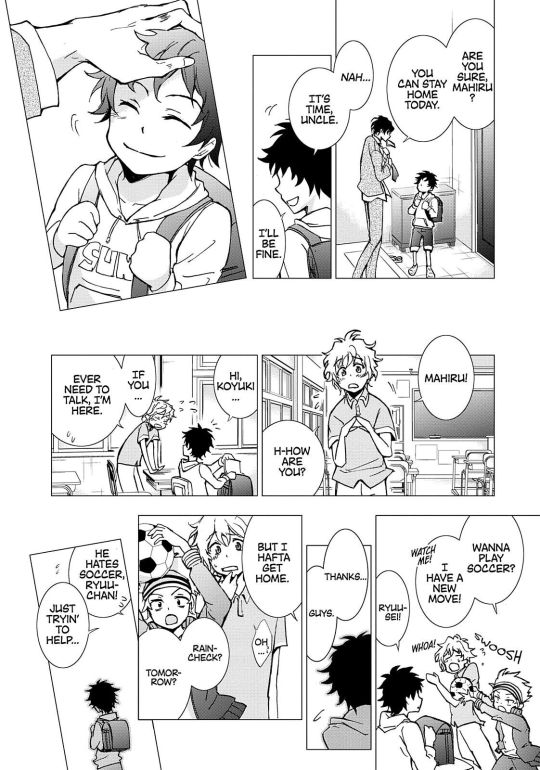
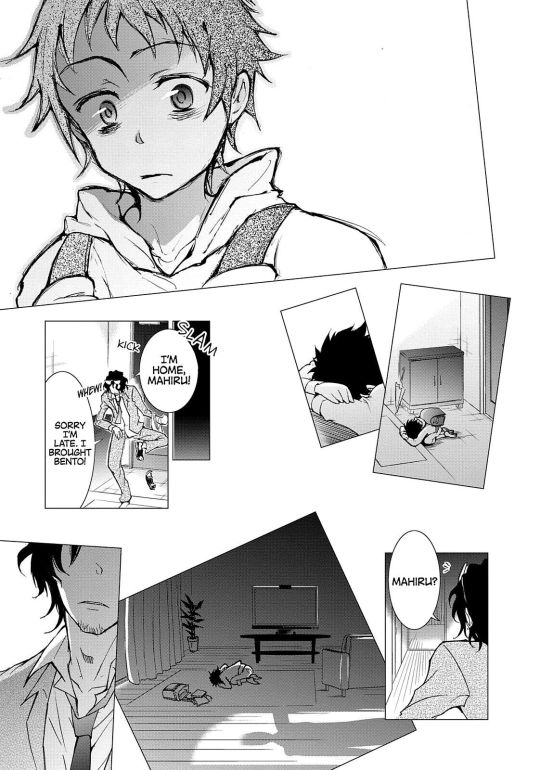
mahiru's deteriorating mental health as he struggles to pretend everything is okay after losing his mother is depicted with the panels getting wonkier and wonkier, as if unable to handle its own weight
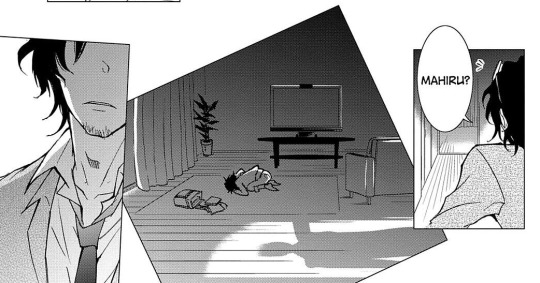
notice how in this sequence, the first panel depicting tooru is standing straight, but after he sees mahiru crying on the floor, tooru's panel is swaying too
but then
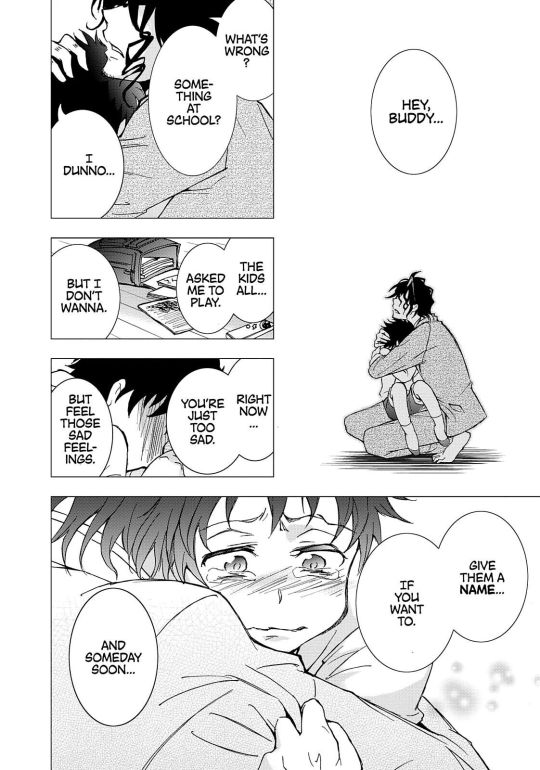
they hug. and the panels are all standing straight again. they become each other's pillar of support.
and i think like... when animated without any special gimmick to it, it won't hit as hard as the manga pages
and there are many, many scenes where tanaka strike plays with the fact that servamp is a book
look at this page from chapter 62
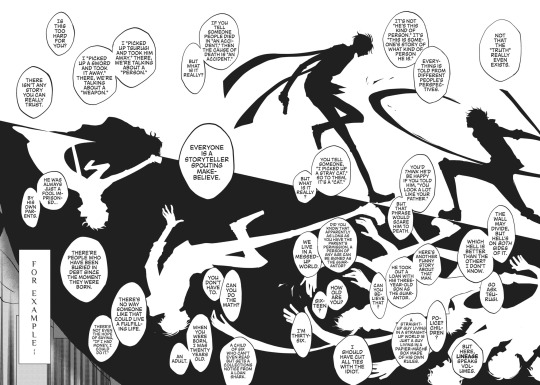
now look at the next page
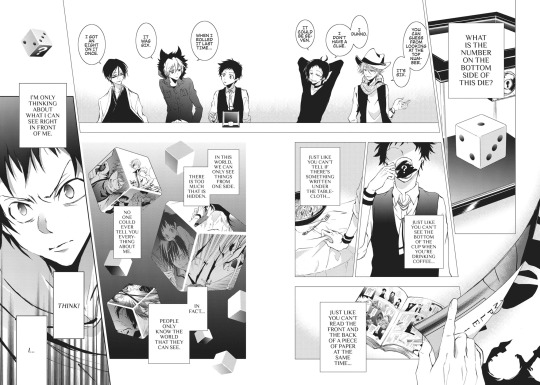
noticed something?
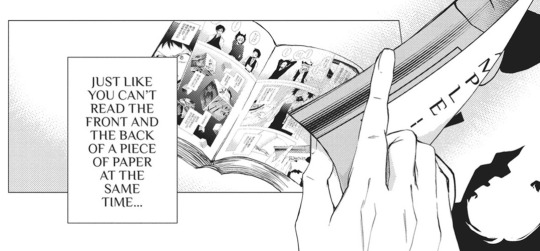
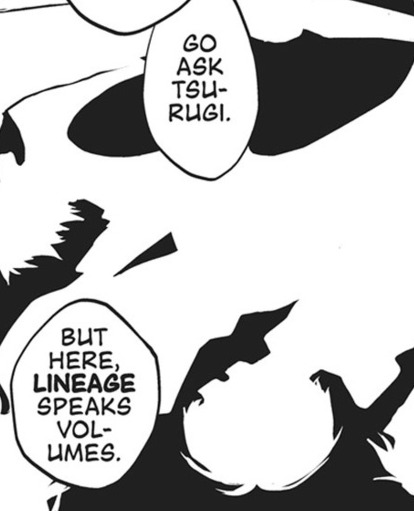
and considering how a lot of adaptations tend to focus on action scenes to sell the anime at the expense of important monologues like this
frankly speaking the only successful anime adaptation i've seen is mp100, and even then, studio bones fucked up literally every other adaptations they handled, like bsd and vanitas to name a few
63 notes
·
View notes
Text
SySpree Digital (India)- Buzzing Social Network Trends of 2024

Social Media Trends of 2024 In this globe of digital communications, the social media sites sphere will be experiencing a major transformation in 2024. The dynamics that have actually dominated systems such as TikTok and Instagram are currently experiencing the start of a new standard, suggesting the beginning of a new age. This year's patterns change from the short-form material mania that has controlled the last 3 years, particularly in popular audio material. These channels' old approach of fast development is now the only compass for brands and material makers looking to stand apart. We have the Best Social Media Trends of 2024.
Long-Form Content Renewal An intriguing reboot taking place in social networks is the return of long-form web content. The last three years saw the explosive growth of short-form material, specifically focused on trending sound as the most preferred approach for expanding on platforms such as TikTok or Instagram. However, the fads of 2024 suggest a significant step away from the brevity that was when the standard for electronic interactions. Change from Short-Form to Long-Form The change from short-form to long-form web content shows an evolution in the techniques used by material creators and brand names. Not limited to the limit of 15 or 30-second videos, the tale is expanding, with an increased focus on deepness, creativity and creativity. The leading social networks agency in Mumbai claims that possibilities are limitless, whether it's adding thoughtful discourse to significant preferred moments or the growth of day-in-the-life vlogs. Social media site is experiencing a change in the 'much less is extra' method that has actually recently been prevalent. Advancement of Video Clip Content on Tiktok and Instagram The advancement of video clip content throughout systems such as TikTok and Instagram is characteristic of this change. Although these platforms originally grew on short video clips, they currently encourage users to check into the globe of longer video clips. This pattern straightens with YouTube's enduring influence, which has actually long been the essential of considerable and full content. Given that YouTube proceeds dominating the marketplace, the more youthful generation naturally accepts the allure of longer video clip layouts. YouTube's Influence on Longer Videos The influence of YouTube is greater than a modification in the web content length. It shows a wider fad towards a more intricate storytelling design that produces a sense of connection and engagement beyond the occasional nature of much shorter videos. The shift is not regarding giving up the charm of style patterns but instead integrating them into a bigger narration canvas. When we consider our social networks trends in 2024, the return of long-form content shows the adaptability and dynamism of the digital setting. It is a break from the days of brief glimpses and fast scrolling. It motivates individuals to remain and immerse in tales that go beyond the superficial. By welcoming this modification, content designers and firms alike can uncover new levels of partnership and creativity within the quickly evolving globe of social media.
Influencers Use Item Positioning In this humming room of social media sites, influencers utilize item placement to accentuate their target market and motivate genuine interaction. Although it's not new, it has changed into a refined yet effective marketing tool, resulting in an uncomplicated integration of items into content that is a hit with audiences. Clara Pierce's Instance A noteworthy instance is the influencer Clara Peirce, that skillfully incorporated product placement right into her TikTok content approach. Taking part in a trending skincare routine video clip, Clara effectively integrated a photo mask within the narrative. The comments section was loaded with queries concerning the mask, showing the effectiveness of this advertising and marketing technique. Additionally, Clara strategically linked the product in her biography, transforming customers' interest right into a workable involvement. Testing by Brand Names with Affiliate Advertising This sort of influencer-led advertising shows a bigger fad to come in 2024. brand names are evaluating associate marketing programs that allow them to be part of discussion much more naturally. As opposed to bombarding people with advertisements that could be extra apparent, firms are turning to influencers to give genuine experiences with their products. The specialists from the leading social media company in Mumbai says this technique does not just pique curiosity yet likewise positions products in a genuine and actual way, producing an emotional link in between brands and their consumers.
Even More AI Integrations In the continuously developing social media sites patterns in 2024, the increasing importance of expert system (AI) is changing exactly how content is made, shared and consumed. Platforms are increasingly taking on AI as a modern technology function and a critical component that improves user experience.
AI's Growing Duty in Social Media Later on, a major player in the monitoring of the social media sites sector took significant action in this instructions through the integration of AI functions into its platform. Launching devices such as Inscription Author, which can create subtitles for social media sites in simply a couple of secs, is an excellent example of just how AI can help enhance and improve production procedures for content. Nevertheless, this advancement has its difficulties and extensive conversations. Worries and Discussions Concerning AI Influencers With all the hype about AI assimilations, a number of concerns have appeared, specifically within the field of AI influencers. As the lines blur in between man-made and human web content makers, disputes regarding originality and the potential issues associated with plagiarism have become more prominent. The leading social media sites advertising firm says the growth of AI influencers has questioned regarding the authenticity and dependability of content developed via non-human entities.
Nostalgia Core As we discover social media sites fads 2024, one distinctive phenomenon emerges as the "Nostalgia Core." Just what is a "core"? In terms of the present, it's the term used to describe common ideas of aesthetics, society, or genres that have actually all been grouped under one class. This Nostalgia Core pattern is obtaining popularity from the generation's passionate love of old-fashioned styles, especially the return of Y2K and 90s fashion. Gen Z's Embrace of Fond memories Gen Z's timeless journey is not constrained to personal preferences; it encompasses forming wider cultural shifts. In 2024, brands are maximizing this cumulative fond memories, crafting advertising strategies that utilize throwback web content to develop a sense of knowledge and link with their target market.
An exceptional picture is the visibility of influencers who curate deliberately low-grade photos of popular products from the 90s to the very early 2000s. For example, fungkiigrrl produces creative collections of video clips of legendary items that have an old-fashioned charm. Also Pinterest in the every year launched Pinterest Predicts report, which describes different classic styles that consist of "Provide a Scrap," Kitchens," and "Eclectic Grandfather," forecasting their appeal for 2024.
Advertising Methods With a Throwback Content The destination of Nostalgia Core is in its efficiency as an advertising and marketing approach. Business are leveraging this trend and producing material that triggers memories and stimulates the feeling of a common past. It does not matter if it's introducing a brand new product featuring retro-themed advertisements or curating sentimental content; marketing professionals recognize the power of taking advantage of the cumulative memory to bond with their target audience.
Changing Browse Practices On the planet of social networks patterns in 2024, there is a considerable shift in search practices improving digital media. For a long period of time, Google has actually been the key online search engine made use of for details, however today, systems like TikTok and Instagram are coming to be one of the most famous sites for questions. Change from Google to Tiktok and Instagram for Search This change is a measure of a larger change in the way that individuals navigate the web. The professionals from the leading social media sites marketing company More than 50% of Gen Z are currently turning to TikTok and Instagram as online search engine, which shows a crucial shift in just how people search for and find material. The trend towards these search platforms shows a desire to have an immersive and engaging experience various from the basic results supplied by the typical engines for search. Relevance of Keywords in Material Optimization The importance of keywords in content optimization is a lot more essential than ever. With an increasing number of individuals counting greatly on TikTok and Instagram to look for brands, designers have to thoroughly include appropriate search phrases in their content. Making sure content is enhanced with the appropriate key phrases will certainly guarantee that it shows up prominently when users look for topics on these platforms. This adjustment needs a shift from standard search engine optimization practices to embrace a more fluid and details context method to making use of search phrases. Advancement of Web Subject Expedition The growth of Web subject exploration aligns with the changing nature of web content usage. Customers are searching for tailored and curated experiences, and platforms such as TikTok concentrate on short-form, interactive web content and Instagram's visually driven search abilities. The specialists from the leading social networks advertising agency claim these social networks trends of 2024 highlight the relevance of not simply producing web content of premium quality but making it extra customized to fit with the moving practices of the customers that see these systems as greater than just social media sites yet as hubs of details and exploration.
Extra Selectivity with Systems When we take a look at the social networks patterns 2024, there is a clear pattern: the need for better scalability with platforms. The universal burnout experience of users, influencers, and social media managers also highlights the need for a purposeful technique to engagement with electronic media. Fatigue on Social Media Site The constant streaming of web content on several platforms can cause wearing out, and it's vital for both companies and individuals to review their strategies. Although a consistent uploading timetable has long been considered as necessary for growth, the emphasis has actually moved to top quality as opposed to amount. This shift signifies identifying that involvement is usually stemmed from involving, well-crafted web content as opposed to an overruning variety of blog posts. Importance of Deciding On Impactful Operatings Systems In a world teeming with new systems that alter quickly, the trick is to withstand the lure of the trendiest and instead try to find systems that match the brand name's goals. It's about making a conscious choice as opposed to succumbing to the pressure of being everywhere all at once. The cautionary tales of platforms such as Lemon8 that liquified after a brief duration in the spotlight highlight the significance of using a strategic and not a spontaneous or responsive strategy. We have the Best Social Media Trends of 2024. Regular Publishing vs. High Quality Quality > quantity emerges as a mantra within social media fads in 2024. The focus on interesting platforms will urge brand names to spend their resources and time to make a substantial distinction while promoting genuine connections with their target markets. Being a lot more careful, both designers and brand names can not just prevent exhaustion but also boost their on-line visibility by giving content authentically resonant with their intended customers. As we relocate through this ever-changing globe and take on various other systems, recognizing and selecting the best systems is necessary to accomplish stable development and success within the frequently altering social networks.
Narration is Much Less Linear The interesting advancement of storytelling is acquiring prestige with the move towards more non-linear stories. The typical narratives were told from beginning to complete. Nevertheless, now developers are trying out mid-way storytelling that provides customers the chance to experience a vibrant and unpredictable narration experience. FOMO-Induced Storytelling Strategies FOMO-induced storytelling techniques are main to this transformation. By giving glances of exciting moments or crucial details midway with a story, developers create anxiety of being overlooked (FOMO) within their target market. The leading social networks advertising company claims the audiences are urged to pay even more emphasis, continue to be interested, and spend more time looking through the content to understand the tale's nuances. Instagram Doubles Down on Gen Z. Amid the social media sites trends of 2024, Instagram is making critical relocate to boost its reach, specifically for Millennials and Gen Z users. Recent details from Statista reveals a substantial rise in using Instagram, not only for Millennials but also within the ever-growing Gen Z demographic. The increase in interaction is a sign of its lasting appeal and relevance, showing Instagram's ability to adapt to the altering choices of users. Meta, the parent business behind Instagram, has actually highlighted its devotion to acknowledging and catering to the needs of Gen Z in its most recent yearly Instagram Pattern Talk. The focus on Gen Z is calculated, recognizing this generation's considerable impact on developing electronic fads. By lining up the functions of Instagram and its components with the Gen Z customers' needs, Meta aims to grow and keep the system's user base and ensure its relevance in the constantly evolving digital landscape. Potential of Instagram Threads. A noteworthy enhancement to Meta's toolbox of devices is Instagram and Threads. While the platform is still struggling to develop a loyal audience like its competitors, its possible to connect with Gen Z can not be ignored. Strings supply customers a much more intimate atmosphere to publish updates with their closest good friends, which lines up with the need for even more private and personalized interactions. As trends in social media sites remain to establish, Instagram Threads may come to be a principal in promoting substantial connections in between Gen Z customers.
Conclusion. The social networks trends of 2024 are a substantial departure from the media that concentrates on short-form content and accepts genuine long-form web content and creativity. From nostalgia-driven renewals to AI integrations, every pattern is a developing change in individual involvement, pushing brand names and developers to straighten with the transforming electronic landscape. As the landscape evolves, those who can adjust and experiment will certainly flourish in the ever-changing globe of innovation.
0 notes
Text

The Girl from the Sea is a romantic, mystical little coming-of-age story, centering on fifteen-year-old Morgan Kwon as she navigates being a high schooler, the child of a divorce, and—although she can’t let anyone, anyone find out—preferring girls to boys. When a mysterious girl saves Morgan from drowning after an accident on a rainy night, Morgan’s world abruptly changes, and she finds it more challenging than ever to keep all the parts of her life in their neat, separate boxes.
Genre: Fiction, Graphic Novel
Target Age Group:
Ages 12-18 (Grades 7-12)
Justification:
While I’ve never read much of Molly Knox Ostertag’s work, her name is familiar to me, both as a library worker and—to be quite frank—as a queer person on the internet. (Ostertag’s wife is ND Stevenson, creator and executive producer of Netflix’s She-Ra reboot; Stevenson has been vocal about Ostertag’s influence on the show.) I’ve noticed this book a few times, and since it has so many of the things I love (gay youth! beautiful art! Irish mythology!), I was ecstatic to find it on the 2022 Top Ten list of ALA Great Graphic Novels for Teens.
Evaluation:
For this review, I will be evaluating illustrations, plot, and tension/mood. Ostertag’s art is colorful and fluid, and beautifully laid out; she uses color intelligently and intuitively to invoke moods like calm, fear and anger—soothing shades, vivid cool tones and warm hues. Layout and composition is used to great effect—some of my favorite panels from this novel were scenes of Morgan and her mysterious new girlfriend enjoying themselves neighboring panels of Morgan’s friends talking to each other without any response from Morgan. In terms of plot, I found this a very charming coming-of-age story, with a mythical twist. Aside from the mythological elements, which draw from Irish selkie lore, the story at its core is a story about growing up and, I think, being scared to do so; Morgan is more than anything afraid, and is constantly hiding her secrets from her family and her friends. Though in the end she finds the courage to open up to both groups, Morgan’s fear of ostracism and of what it means to be someone different is very relatable to what I remember of my teens. This story is only emphasized by the mythology present in the novel, and in some ways, the parallel of choosing to wear or shed one’s skin applies to both Morgan and the selkies. Both the plot and Ostertag’s art work, with great affect, to provide great tension and mood; while both Morgan and her new girlfriend have secrets and plans of their own, they’re each revealed one by one throughout the story—Morgan is at one point outed to her family by her brother, and the reader learns the mysterious girl’s real reason for approaching Morgan long before Morgan ever does. The pages of Morgan’s group text juxtaposed against her actions in real life is a wonderfully effective way to show that tension: Morgan’s friends all wonder what she’s doing, doing their best to include her and speculating what could be keeping her so quiet, and have no idea that she’s so busy spending time with another girl. (Spoilers: they’re fine with the girlfriend, but not so much the hiding.) The Girl from the Sea was a delicious read—like I said before, it includes so much of the things I love that I don’t think I had a chance not to like it. I would definitely recommend it to young queer teens, but I plan to find a copy of my own to take home.
References:
2022 great graphic novels for Teens top ten. Young Adult Library Services Association (YALSA). (2022, February 7). https://www.ala.org/yalsa/2022-great-graphic-novels-teens-top-ten The Girl from the Sea by Molly Knox Ostertag. The Scholastic Parent Store. (n.d.). https://shop.scholastic.com/parent-ecommerce/books/the-girl-from-the-sea-9781338540574.html Ostertag, M. K. (2021). The Girl from the Sea (M.K. Ostertag, Illus.). Graphix.
#the girl from the sea#a: molly knox ostertag#i: molly knox ostertag#tag: young adult#g: graphic novel#g: fiction
1 note
·
View note
Photo








charmed reboot layouts.
like if you save.
I do not need credits but I appreciate them ( tw acc @dearmarauders )
don’t repost without asking or claim as your own.
#charmed icons#charmed layouts#charmed packs#charmed reboot icons#charmed reboot packs#charmed reboot layouts#melanie vera icons#mel vera icons#melanie vera packs#melanie vera layouts#macy vaughn icons#macy vaughn packs#macy vaughn layouts#melanie vera#macy vaughn#maggie vera icons#maggie vera layouts#maggie vera packs#maggie vera#melonie diaz icons#melonie diaz layouts#melonie diaz packs#melonie diaz#madeleine mantock icons#madeleine mantock packs#madeleine mantock layouts#madeleine mantock#sarah jeffery icons#sarah jeffery packs#sarah jeffery layouts
79 notes
·
View notes
Text


credits to @euphoricstvrs on twitter if used.
11 notes
·
View notes
Note
what kind of pins are u gonna put in ur itabag dani!!!!! i have several of them n it’s so fun i can’t wait to see ur layout :^D
oH I GOT A TON OF Pins already !!
i am to lazy to get up and get a pic but so far I have pins from
DBD (huntress and amanda), billy the puppet, michael myers, annie wilkins, carrie, driller killer, jennifer’s body, dani midsommar, 2 beetlejuice pins (and a matching lydia pin), brahms, haunted mask goosebumps pin, slumber party masscare curling iron pin, 2 freddy krueger pins, It pins from both the reboot and he original, vladislav cat, final girl pin, samara pin, camp crystal lake pin aaaaand a ‘whats ur favorite scary movie’ pin
and then i have ‘gore whore’, tiffany valentine, amanda young, and hamtaro sam from trick r treat charms on my zippers OASIDK
8 notes
·
View notes
Text
Action Comics #1022 Review
“The House of Kent: Part 1″
Starting off, we have the 9-panel grid. Because Tom King likes to use it to show off that he read Watchmen (before promptly abusing the layout to death), everyone and their mother has been scrambling to shove it somewhere in their work and try to get a useless amount of perceived street cred to show that they too had read Watchmen (killing the layout even more). Since it’s all the rage, Bendis does it here.

I actually like the third panel. As Stan Lee said, every comic is someone’s first comic (and this is the first chapter in a “highly” anticipated arc). Instead of an editor’s note, Bendis explains Kelex through dialogue that is expositional but not unnatural or clunky. But why explain Kelex of all things? My answer is well, why not? Supposedly, Conner is as unformed about a lot of things as is a potential new reader and Superman informs him in a manner that is not entirely out place, even to current readers.
Then Conner explains his origin and touches upon the fact that we’ve had a few different continuities since his creation in 1993. He is excited and curious in the first four panels and then immediately deflates in the last four. I think Bendis is trying to have the best of both worlds by writing both an excited Conner (something that fans are supposed to respond positively towards) and a depressed Conner (because he has been a victim of the discontinuity perpetuated by DC editorial and made no better by Bendis).
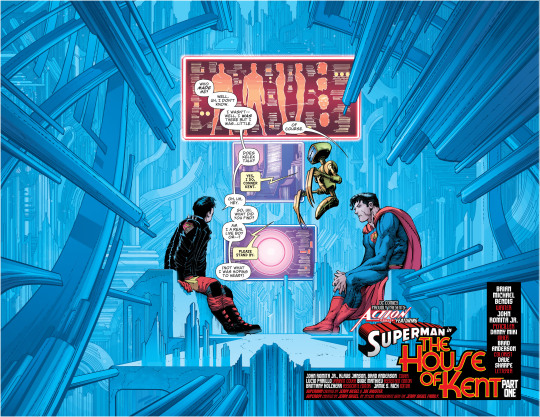
We get a double-page splash of the two Kents conversing that I like, especially the color of the Fortress. The conversation is very Bendis, but not offensively so. It serves its purpose, can’t be too upset about that. He tries to depict Conner as nervous, but I really hate how it’s done, it’s like reading an accent phonetically.
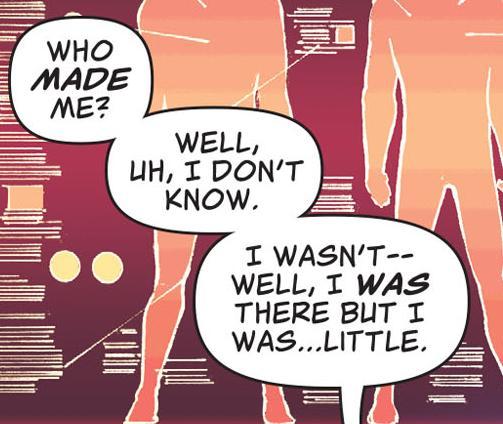
uwu what’s this? A fundamental misunderstanding and misinterpretation of a character? In my Bendis book? It’s more likely than you think.
Conner has literally never been little. He was created as a teenage clone of Superman and he stayed a teenage clone of Superman. He came out the test tube the punk Metropolis Kid, not the toddling Metropolis Tyke. A really big conceit of his character is that he will never look older or younger than a teenager. That’s why a lot of eyebrows were raised when in his first reappearance Bendis chose to depict him with stubble.
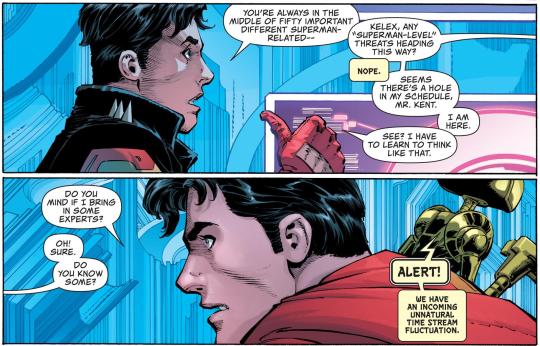
Another example of Bendis-speak that is fun and full of charm and character, but the characterization for the characters who are conversing is just…off. It’s a conversation these types of characters would have, just not these characters specifically.
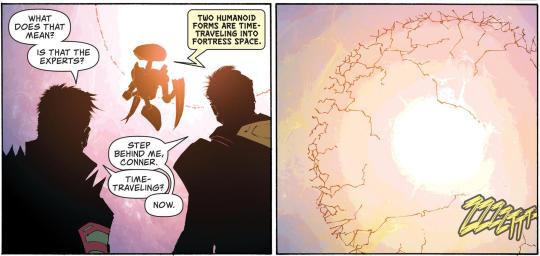
You know, for a character that supposedly Bendis hates and wants to write off and make inaccessible to all other writers and artists, he sure writes about Jon a lot. Bendis forces Jon into the future, cutting him off not just from everything he knows and loves, but from, more importantly, the readers. This reinforces the gravity and seriousness of him being written off, but Bendis constantly undermines this hostage situation of his own creation by having him come back to the present quite often. You put characters on a bus to make them go away forever, but the bus keeps returning to the station. And the most baffling part? You’re the driver, Bendis! Commit to the fucking bit!

Jon and Braniac 5 are chumming it up, because they are toooooootally buddies, you can read alllllll about Jon’s actual, very real, and totally not non-existent friendships with the Legionnaires in Legion of Super-Heroes by Brian Michael Bendis and Ryan Sook, because Jon totally has finished watching the Legion orientation film that totally didn’t take more than 5 issues to even get him to watch and he wasn’t even interrupted once. The book is soooooo well developed and evenly paced and not at alllllll bloated behind belief.
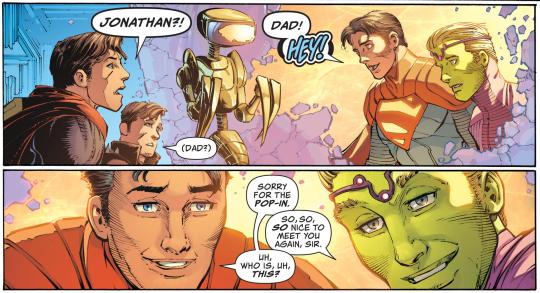
Jon acts like he came home from college to do laundry and eat some home cooking and forgot to call ahead, like he totally isn’t supposed to stay in the future.

Me, too, Conner. I don’t know who this character is either.
We also get to see his new costume here, which I hate. The one positive thing I could say about this new character when he was first introduced in Bendis’ Superman run was that I really liked his costume. It had the cyber-armor look of the New 52 Superman suit, but wasn’t too over-designed. It worked, it looked cool. This new look is just kinda bleh. It has the ugliness of the New 52 with none of the intricacies that made it look cool and unique.
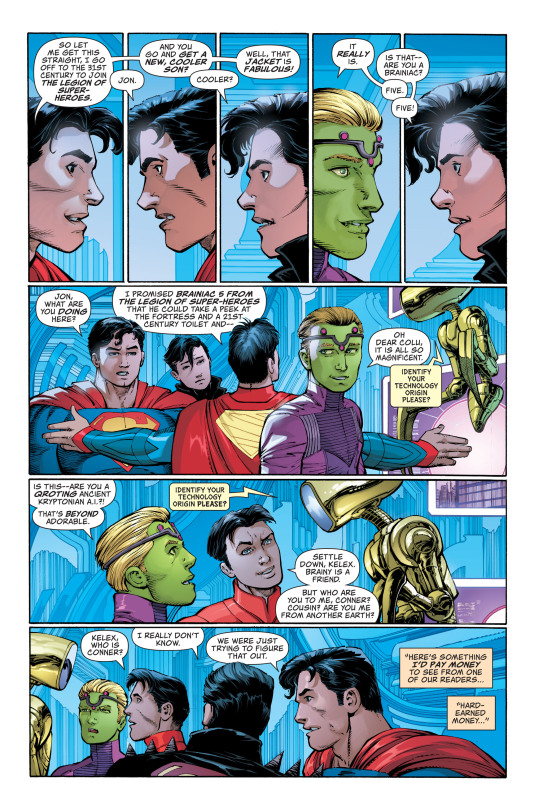
We were never going to any meeting between the two Superboys that can even remotely be called good or worthwhile. I appreciate the naiveté of certain fans who enjoy things at face value because, factually, they got what they wanted. Fans wanted this meeting and they got it, which will make the happy, but it is not at all satisfying, which is what they should care about.
Bendis has a firm understanding of Superman and his voice. The same cannot be for Jon Kent. This character is not Jon Kent. He is not written out of character because this is not his character. What we got here is not what we wanted. This is Bendis and DC editorial banking that fans will rationalize to themselves that the crumbs they deigned to give fans is actually a feast worthy of praise and exaltation (look no further than Superman #16).
Oh and by the way, this is all we get for the meeting. The rest of the issue is “wHaT’S ThE DeAl cOnNeR KeNt?”
I’m skipping over the Daily Planet stuff because I don’t care about it and it doesn’t piss me off.
Instead, I will quickly address this: “The rumor come out, does Jonathan Kent is gay?”
I want to say this came about because Jon called Conner’s leather jacket “fabulous”, but it seems this idea existed before this issue was even released. The most I can find in relation to Jon being gay is this article written 2016 and this funny little exchange in the comments of one of Bendis’ Instagram posts.
I knew I was not straight when I was in grade school and it would be amazing if such a high profile character like Jon came out. It would normalize the idea that being gay isn’t something exclusively sexual or adult, but that there is nothing wrong for kids to have feelings for someone their own age who is the same sex. But I don’t trust DC to even attempt this. If they can’t even make Dick Grayson bi, then it’s not likely for any other character to come out.
And just because he described something as “fabulous”, that doesn’t make him gay. It’s an odd choice of words, sure, but word choice is no real indication of sexuality. In an interview with ComicPOP, Todd McFarlane described a box for a figure as “sexy” and “sassy” that I might have instead referred to as “cool” or “awesome.” I think Todd’s word choice is oddly fitting, but it was not something I would have thought to use before hearing him use it in the interview, and it does not at all call into his sexuality. I have a similar sentiment about “fabulous.”
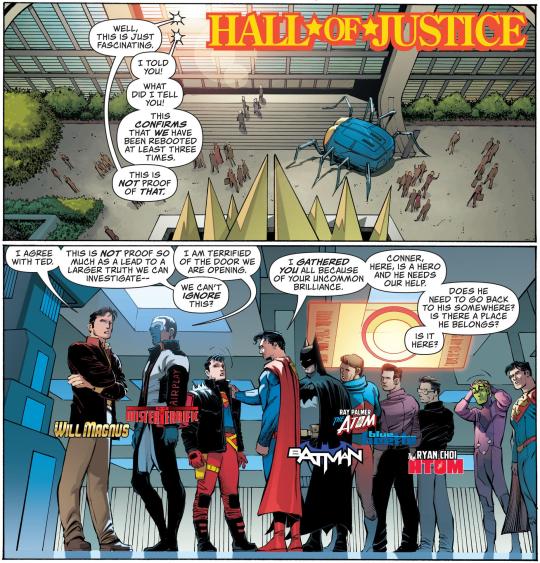
Back to the story, Superman takes Conner to meet some of the intellectual experts in the DC universe to help figure out his deal. They have some “fun” Bendis dialogue and touch upon the multiverse and continuity that Bendis has been helping shape even though he literally has never worked for DC until very recently, relatively speakingm and yet is being trusted with the word “crisis.” And what do you mean you’ve been rebooted at least three times, I thought it was seven times according to Young Justice #1, one of the first issues Bendis wrote for DC.
I saw a Reddit post a little while back that compiled clues and subtle hints that were spread out among several titles, including Tom King, Scott Snynder, and Bendis’ various books, that tied them all together with Doomsday Clock. It demonstrated a remarkable amount of coordination that I thought impossible given who it involved, but the evidence was pretty convincing. However, this was before Dan Didio was fired and they were able to avert 5G. Now that they’ve had time to regroup, I think this issue is sowing some more of those seeds that’ll eventually be dealt with by Synder’s Death Metal.

Here’s some more of that fundamental misunderstanding and misinterpretation of a character. Conner was not “raised” by the Kents. They cared for him, sure, but I wouldn’t call what they did raising.
What is being referred to here is Geoff Johns’ run with Conner Kent in Adventure Comics which took place in 2009. What that contributed to the character was only a relatively recent development in Conner’s history. It should be noted he started living with the Kents in 2002. His solo book was cancelled with Connor being dropped off by Clark at his parent’s house on the very last page. Any sort of “raising” would have occurred off panel during that time and is largely not expanded upon because there was literally no book to depict that kind of relationship until after he had died in 2006 and was brought back in 2009. They are not the sole contributors to his life like it is implied here. He lived in Hawaii and worked for Cadmus for far longer than he lived with the Kents.
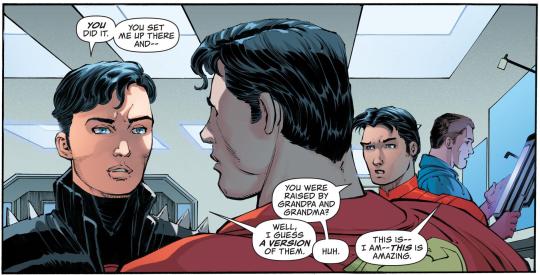
And here we have Jon casually referring to Ma and Pa Kent as Grandma and Grandpa like he actually knew them instead of just knowing of them. For those of you don’t know, they were dead when Tomasi and Gleason were writing Superman and were only just recently brought back in Doomsday Clock which concluded well after Tomasi and Gleason had left the book, so Jon never met them. At the absolute most he’s heard stories, looked at pictures, and seen home movies of the Kents. You could say I’m nitpicking, but Bendis deserves it. You can feel his disregard for others’ work throughout his other books, and its panels like this that are the proof.

Jon literally has no reason to know that Ma and Pa Kent are alive. No reason. Jon’s smug face is Bendis’ way of say “Aren’t I a stinker?”

Fuck. You. Bendis.
You do not get to pretend that stories you made impossible to tell of Jon spending time with his grandparents actually did happen. Is this interaction cute and fun and a little bit wholesome? Yes. But is it genuine? Absolutely not. He’s just trying to cash in on what he thinks fans want to see with none of the heart and soul.
And now Clark is acting like Jon is visiting from college.

Piss your pants, Bendis. Jon would never refer to his best friend Damian Wayne like that. If someone else referred to Damian like that when Jon was around, he would correct them and say something along the lines of “He’s not so bad once you get to know him.” Stop pushing the narrative that Damian is some sort of demon hellspawn or psycho killer. He’s a flawed kid with a dark past that wants to be better but struggles with it and needs friends like Jon to support him. This continues to show that Bendis literally does not understand this character and why fans get upset when he writes him this way.
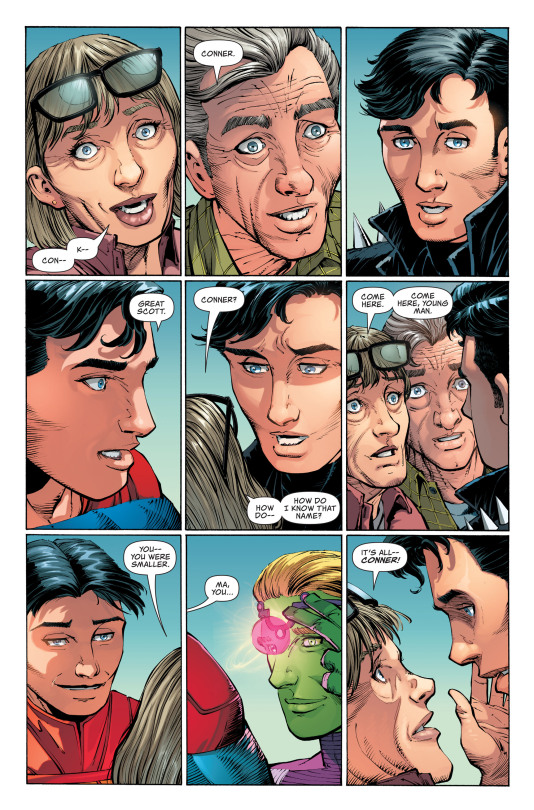
Another 9-panel grid, but this is not Tom King-inspired, but actually befitting the moment. Bendis still think Conner was literally raised by the Kents instead of just living with them, but I really have no skin the game of Conner being recognized as a part of the Kent family, so this doesn’t piss me off much.

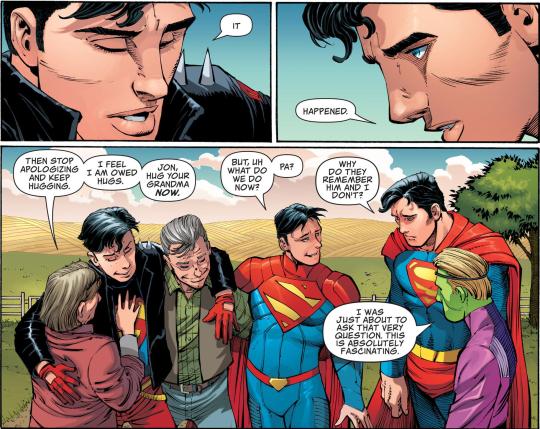
I know this is supposed to be emotional because they just reunited, but the dialogue seems to suggest something more ominous and insidious is going on, something bigger than any one of them (Crisis, I know, but its kind of obnoxiously on the nose and yet unnecessarily vague).
The issue actually ends with the story I don’t really care about, so that’s the review.
Note: I realized about part way through writing this post how pissy and whiny I might sound, but I spent too much writing it to not post it.
#action comics#superman#conner kent#superboy#jon kent#legion of super-heroes#brian michael bendis#clark kent#brianiac 5
9 notes
·
View notes
Text
Rant: The Nightmare of Steam Input

It’s hardly a surprise these days that something built by Valve Software is maybe not the most solid, well-thought-out decision anyone’s ever had. When it comes to Steam, it can sometimes feel like a cobbled together set of half-finished features. Remember Steam Music, when they were going to implement a way to listen to custom music during gameplay? Remember when they used to sell movies? Or what the “Steam Machines” initiative, when Valve was going to partner with different hardware manufacturers to sell pre-built PCs, likely in a move that was meant to mimic to how Google handles their Android phones?
And then there’s the Steam Controller, built on the back of the “Steam Input” API. Though the controller floundred, Steam Input ended up being far more interesting. The theory: plug any controller in to Steam and it just works. Does the game ask for an Xbox controller, even though you aren't using one? Steam Input will take care of that. Does the game not even support controllers at all? Steam Input can make that work, too. And for games that interface with the Steam Input technology directly, a whole host of new and exciting features get made available, like binding specific actions to a Playstation 4 controller’s touchpad, or a Nintendo controller’s motion control.
On paper, it sounds great. But like a growing number of ideas out of Valve, in practice, it’s been kind of a nightmare.

The most recent example of this has been the launch of No Man’s Sky BEYOND, billed as one of the biggest content updates that game has ever seen. Previous PC builds of No Man’s Sky relied on basic, functional Xbox controller support. It operated very similar to the original Playstation-4-exclusive console game, but now on an Xbox controller. If you used anything besides an Xbox controller on PC, Steam Input’s base function would kick in, which in my case meant my Playstation Dualshock 4 controller would be seen as (and function identically to) an Xbox controller with zero fuss. It worked flawlessly.
With the release of BEYOND, No Man’s Sky has transitioned into using Steam Input to its fullest extent. No longer does it pretend you’ve got an Xbox controller connected, it now attempts to support the features of your controller directly. In theory, this should mean far better and more robust controller support!
Except that, as of this writing, it doesn’t work. It doesn’t work for Playstation controllers, it barely works for Xbox controllers, and it even seems to have mucked up keyboard support for some. Thanks to Steam Input, the game is now more or less unplayable in many different configurations.

In my personal experience, this manifests itself by only some of my Dualshock 4 buttons working, and only working some of the time. The power of Steam Input means developers can insert hooks to completely remap all your controller buttons depending on the context. So, for example, let’s say you’re playing a game like Grand Theft Auto. If that game supports Steam Input, the developer could set it up so you could change your entire button layout depending on whether you were walking around or driving a car. They could even set it up so you could have different buttons depending on whether you were driving a car, motorcycle, boat or airplane.
This is what No Man’s Sky now does, with half a dozen different contextual button layouts for flying your ship, exploring on foot, using certain weapons, organizing inventory, dealing with merchants, and more. While cool in theory, it’s a little overwhelming to actually consider customizing your controls. You must now dig deep and decipher what button you want to change in which context, and that’s assuming everything is working as intended.
In practice, this currently means some controller functionality only works when certain menus are visible. For example, I can only aim with the right stick while the build menu is up. Close that screen and my view instantly freezes. As I said earlier, it’s more or less unplayable.
To a certain degree I forgive the developers of No Man’s Sky (Hello Games) for this. Signs do point to something changing behind the scenes within Steam Input recently. Other, older games have been silently breaking in the last few weeks. The 2012 PC port of Sonic Adventure 2 suddenly asked me to reboot the game after informing me that my controller type had changed, and I had to remap all of my inputs in Gas Guzzlers Extreme after it, too, detected a change in Steam Input’s Xbox controller support (all its buttons had to be rebound to a “new controller” after the “old one” stopped working, despite no hardware change on my end).

It’s possible that a version of No Man’s Sky from a week or two ago worked fine with Steam Input, and now a change on Valve’s end of things has thrown everything into disarray. It's equally likely a patch will fix things up sooner rather than later (maybe even by the time this post goes up).
That excuse does not apply to a game like American Truck Simulator, however. It’s a story similar to No Man’s Sky, except while I expect No Man’s Sky is trying to use Steam Input to approximate the original controller setup (just with more depth to what buttons you remap), American Truck Simulator inexplicably did the opposite of that.
The game launched with Xbox controller support, meaning you could effectively use any controller with the game via Steam Input’s basic functionality. Sometime around the end of 2018 that changed, with SCS Software ditching Xbox support in favor of direct Steam Input support. But it’s how they did this that ended up so baffling.
Instead of updating their controller support to use Steam Input, they seemingly stripped all controller support from the game entirely, busting American Truck Simulator back down to basic keyboard controls. Then, using Steam Input, they created a custom controller configuration that translated to those keyboard keys to controller buttons. In other words, let's say the "F" key on your keyboard handles turning on your headlights. Using Steam Input, SCS Software made it so hitting the controller's X button would activate the F key on the keyboard, thus toggling the headlights. In theory, this is great, because you can use both the keyboard and the controller at the same time without changing any settings.

But it also meant that when I put down American Truck Simulator mid-2017, how the game controlled changed (relatively) overnight. Booting it back up a year later, all my buttons did something completely different through no fault of my own, and it took a lot of detective work to figure out why. I had to spend more than an hour untangling this new mess and putting everything back the way I originally had it. By the time I was done, I was too fed up to actually play American Truck Simulator.
Next, let’s talk about the exciting new features afforded by Steam Input. Though fully-featured official drivers for Playstation and Nintendo controllers are hard to come by on the PC, Steam Input enables features like the Dualshock 4’s gyroscope, allowing developers to make games with motion control in ways that would have been impossible. A whole new era of innovative uses of tilting your controller could begin!
Has anyone done anything like that? Nope, not really. Unless you count VR, but that's mostly with VR-specific controllers.

Instead, we get developers going rogue, implementing gyroscope functionality where none existed. Take Ubisoft’s Grow Home. Developed as a tech demo for a procedural climbing system, Ubisoft spun Grow Home off into a sort of big-budget indie game. You play as a charming red robot named B.U.D. as he ascends his way up a gigantic alien tree. At the very top of the tree sits his spaceship, and his central computer, M.O.M.
Grow Home uses Steam Input and plugs in to the Dualshock 4’s gyroscope, nauseatingly giving you the ability to control the game’s camera by tilting your controller. It doesn’t tell you this, you just start the game with B.U.D. staring at the floor, gently twitching from your slightest movement. What makes this crazy is the fact that if you were to play Grow Home on an actual Playstation 4 console, this gyroscope camera feature is not present. Same controller, same game, but for some reason Ubisoft secretly gave the PC version gyroscope features thanks to Steam Input.
The exact same thing happened with Croteam’s The Talos Principle. Here’s a first-person puzzle game about redirecting laser beams to unlock doors, available on just about every platform that will take it. On a Playstation 4 console, it controls like any other standard first-person shooter -- left stick moves, right stick aims. Connect your Playstation 4 Dualshock to your PC and play The Talos Principle on Steam, and suddenly you have all-new gyroscope aiming for no logical reason, necessitating a dive into the game’s settings so it can be turned off.

This could perhaps be explained by the environment Valve has cultivated on Steam. On a console, there’s a laborious, and sometimes even expensive “certification” process games must go through to release. Additional rounds of certification is required to issue updates and patches. Usually, platform holders require games to meet certain standards of functionality as to avoid driving away potential customers and spoiling the marketplace for everyone else.
On Steam, that all gets thrown out the window. For a small, one-time submission fee, anyone can publish (almost) anything on Steam and update it instantly, for free, forever. Any whim you have can be instantly realized for zero cost other than the time it takes to implement. New gyroscope controls? Sure, why not! Who’s going to tell you no? Definitely not Valve, that’s for sure.
This lead to the worst of all worlds. I suffer from occasional flare-ups of carpal tunnel syndrome thanks to art-related pursuits. One night a few months ago I found myself with enough discomfort in my hand that I tried playing Valve’s own Left 4 Dead 2 with a controller. Besides launching on PC, Left 4 Dead 2 had console ports on the Xbox 360 and Playstation 3. As such, the PC version originally received standard Xbox controller support. And more than once, I’d fallen back on playing L4D2 with a controller for any number of reasons. It wasn’t as accurate as using a keyboard and mouse, but in a pinch it was convenient, functional and comfortable.
Booting up Left 4 Dead 2 in 2019 and grabbing my controller, just like with American Truck Simulator, I was met with a top-to-bottom control system rewrite made to accommodate Valve ditching Xbox support and replacing it with Steam Input. This meant that none of my buttons were the same anymore.
And, just like with Grow Home and The Talos Principle, suddenly Left 4 Dead 2 also had completely unnecessary (and frankly, hyper-sensitive) gyroscope aiming bolted on over the top, even though I didn’t need or want it. It was like I stepped on to an alien planet.
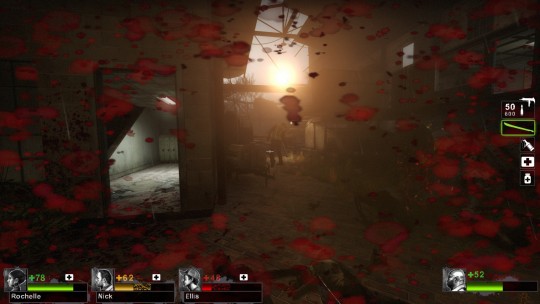
Worse yet, this new Steam Input configuration was actually a step back from the previous Xbox controller config.
Left 4 Dead 2 was old enough that it was an early game to feature emotes on a radial wheel chosen using the analog stick. This made it easy to communicate with teammates even if you didn’t have a headset for voice chat. To some degree, it was made specifically for a controller. In Valve’s new, official Steam Input controller config for L4D2, the option to show these chat shortcuts was removed entirely. So not only were all my buttons different, but some old functionality was now gone. Why? Why not, said Valve. After all, nobody is going to stop them.
To butcher a quote from Jurassic Park’s Ian Malcolm, just because you could, doesn’t mean you should.
The solution to this is the same solution Valve has for everything they do nowadays. Steam Input is not a closed system. You can, if you so choose, connect to an online database where users share their own custom controller configurations. In Valve's eyes, the “Free Market” solves all problems, even problems Valve makes for themselves.
Assuming your needs match the free market, anyway. You may spend just as long browsing and testing other people’s Steam Input configs as it would take you to dig into the settings and fix it yourself. Either way, it’s an unwanted distraction.

The greatest benefit of Microsoft standardizing PC game controllers via the Xbox 360 was that you simply plugged in the controller and it worked. No mapping buttons, no detecting analog stick ranges, no fiddling with any of the options menus. The game in question simply said, “I know what this is!” and you were ready to go. The only problem with that was it only applied to Xbox controllers, a problem Steam originally solved. Thanks to Steam, every controller was functionally an Xbox controller!
But as is increasingly the case, Valve’s aspirations to be more than simply a library of PC games outstripped their ability to control the quality of the input or output. They fixed a very important problem, but were so determined to prove their own intelligence that we've landed right back where we started: forever tinkering with options menus when we could just be playing video games like we wanted.
#steam#valve#no man's sky#the talos principal#hello games#croteam#writing#long#left 4 dead#xbox#controller#switch#nintendo#gamepad#playstation#dualshock#feature
15 notes
·
View notes
Text
B-Squared’s Top 10 Games of 2019!
2019 was a year full to the brim of GREAT games, and as is the custom at the end of the year, people love to rank their favorites, so…I’d like to do the same! Of course my own tastes might be different from yours so if you don’t see a thing on here that you liked, chances are I didn’t like it…or more likely, there’s just too many great games out this year, and I couldn’t get to everything. I’d like to stress to that the rankings don’t really matter all that much, especially the farther down we go. Everything on here is an easy recommendation. Without any further ado…let’s take a look at my Top 10 Games of 2019~
#10 - River City Girls
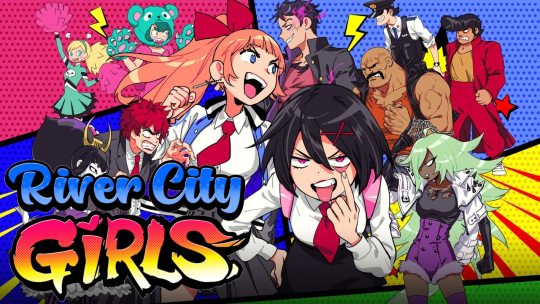
I love action games, but 2D beat-em-ups never really clicked for me. They were largely before my time and I was thinking that it’d be impossible to get me into one in the current era of gaming. And then I saw Marian’s redesign for River City Girls and bought the game. What can I say? Abs are a great sales pitch. But seriously, getting Wayforward on the helm of a beloved classic franchise is already a great way to pique my interest, and while there’s SOME aspects of this game that I don’t quite gel with, it’s a fun, colorful romp through a ridiculous universe that I’d LOVE to see more of down the line. Featuring a role-reversal, with the girlfriends saving the boyfriends this time, River City Girls has gorgeous pixel art, an AMAZING pop-synth soundtrack that’s worth the price alone, and it’s a game that clearly had fun with the concept and that fun rubs off on you. From the stylish animated boss intros, to the co-op fun that can be had with a friend, everything in this game is brimming with charm. Basic NPCs have great designs in their own right, being able to recruit enemies as assists is a neat idea, and it all adds up to a fun, bite-sized adventure with a bit of depth under the hood if you’re willing to give it a look. Can the character designers get a raise for this game, please? And let Megan McDuffie just do all the songs from now on. ALL OF THEM.
#9 - Astral Chain

Most people assumed if we were going to get a Switch exclusive game by Platinum this year, it’d be Bayonetta 3 but instead Nintendo surprised us with Astral Chain, the anime cop action game we didn’t know we wanted. The game boasts great visuals and is probably the most content-rich Platinum game ever made for starters, but for me the true draw is in the combat. Playing as your police officer in tandem with an alien creature known as a Legion, this tag-team action game is unlike pretty much anything else on the market. While the game starts off very simplistic, the Legion itself moving and attacking with no input from the player, over time more and more options unlock and things get considerably more complicated. By game’s end, you’re drowning in options, and once things clicked, combat was always a treat. With plenty of enemies to practice with, Legions to master and a gigantic post-game filled with challenging encounters, I had more fun with the combat in this game than I did with a lot of other games this year. That said, I do feel that Astral Chain could have benefitted from trimming some fat or rethinking its overall structure. For being a new IP with some bold ideas, I’m willing to accept these as kinks that can hopefully be ironed out in a sequel. Oh, and add Lappy to Smash already. You know you want to, Sakurai.
#8 - BABA IS YOU
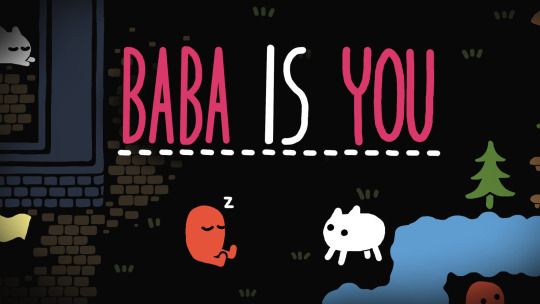
Puzzle games are hard sells for me, since I don’t like the frustration that often comes from being stuck. You feel dumb, you get embarrassed and turn the game off in shame, or at least that’s my experience. But then sometimes you get a game so clever, so…weird, that you can’t help but be sucked into it. BABA IS YOU is a block-pushing puzzle game, with the twist being that the “rules” of a particular stage are often physically present in levels and are in fact blocks that can be pushed and manipulated by the player. ROCK is PUSH, WALL is STOP, FLAG is WIN and BABA is YOU. But what if you can’t touch the flag because the wall is in the way? Well, make it so WALL is PUSH to move it aside, or maybe make it so that BABA is WIN and you become the win condition itself. As the game goes on, more modifiers and rules are slowly introduced and absorbed into your own internal logic of the game, logic that increasingly has to be broken and remade to suit your needs. It’s a very empowering experience when the solution clicks and the results can often be hilarious and surprising. This game also GOES PLACES the further you go in, and I’d rather not ruin that surprise for anyone who might be looking into the game. Definitely one of the most innovated titles I’ve played in a LONG time. BABA is GOOD.
#7 - Power Rangers: Battle for the Grid

OK, so…hear me out. Power Rangers was a franchise I was obsessed with as a kid, and while I don’t follow it anymore, there’s still some love for it flowing in my veins. So when a small, no-name studio puts out a Power Ranger fighting game that takes the simplified controls of Smash Bros. and the tag-team craziness of Marvel vs. Capcom and slaps it all together for a cool twenty bucks or so? Well you got yourself a purchase and it ended up being WAY more fun than I expected. Power Rangers: Battle for the Grid is far from the best looking fighter on the market, it’s single-player content is lacking, and it’s roster, while interesting, isn’t as big as a lot of the competition, but damn if it isn’t fun to play. With characters taken from across the franchise’s long history, from the live-action movie reboot to the comic books, each choice has been inspired and resulted in an incredibly varied cast. With no crazy inputs for special moves, combined with a tagging system that lets you cycle through your three-Ranger team quickly, the game is the best kind of chaotic fun, but true masters can command that chaos and channel it into cool combos that make you want to say “Morphinominal!” Considering it’s a budget title, it’s also received a fair amount of updates throughout the year to pad out the roster with both free and paid DLC fighters, a full story mode and improvements to the netcode and overall presentation., so if you passed on it at launch, it’s much improved now. It’s not gonna be a fighting game on everyone’s radar, but I’d rather support it than the grind-heavy slog Mortal Kombat has become…Now just hurry up and add that monster that baked the Rangers into a pizza!
#6 - New Super Lucky’s Tale
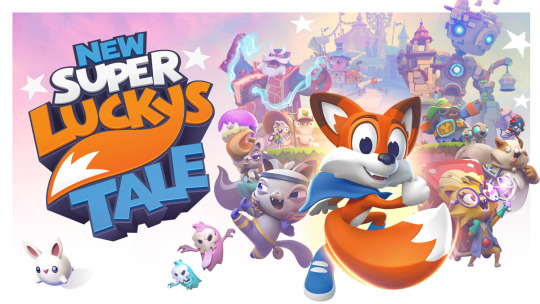
If your name isn’t Mario or Sonic, 3D platformers are effectively dead. That said, there’s been a few up-and-comers in recent years that are trying to revive the genre. Hat Kid from A Hat in Time, the duo of Yooka-Laylee, and now Lucky from the folks at Playful Studios. The cute fox has quite the history, starting from the Oculus Rift title, Lucky’s Tale, to a full-fledged platformer on the Xbox One X, Super Lucky’s Tale and now the enhanced port/reimagining New Super Lucky’s Tale on Switch. Halfway between a full-blown sequel, and enhanced edition, the game takes assets from the Xbox original game, tweaking and refining everything from visuals to controls to level layouts. The result is a game that is incredibly well-polished. It looks great, Lucky is a treat to control as he moves from jumping, burrowing and sliding around fluidly, and the variety on display keeps things interesting. We’ve got full 3D levels, 2D levels, auto-runners, and even some marble maze levels and puzzles thrown in for good measure. It’s not a hard game, but it IS incredibly fun, and well made. We don’t get many 3D platformers these days, so cherish what little comes of the genre. I hope Playful and Nintendo continue to collaborate, as they really seem more at home here. Just…maybe don’t add more words to the title of the next game, guys.
#5 - Katana Zero
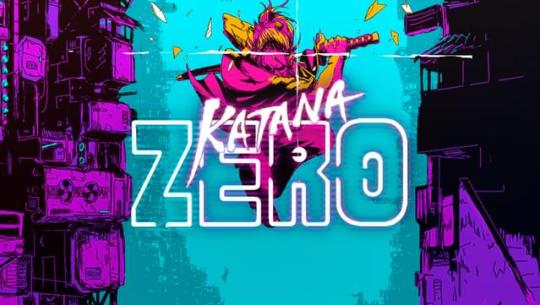
There’s no nice way to say it: there’s too many pixel-based, side-scrolling indie games out there, so the ones that DO stand out deserve to be celebrated. Katana Zero has a real ‘80s flair for starters, using bright neon, TV and VCR visual effects, and a synth soundtrack to give it some real style. When a game kicks off with you slowing down time and reflecting a bullet back at an enemy with your katana, you make a good first impression! Add in the trial-and-error that is planning the perfect route through a stage, the satisfying slicing and dicing of enemies, the unique, challenging boss encounters, and you have a game that was on my radar for a while, before I finally got into it at the end of the year. Its storyline is pretty interesting too, with some slight variances in how events unfold depending on your words and actions, though it ending on a bit of a cliffhanger is a bummer. That said, when a game leaves you wanting more, there’s worse problems to have. At the very least, there’s some DLC hinted at that might be interesting, as well as the implications that this is the merely the first in a trilogy, and at this point I’m game for whatever developer Askiisoft has in store.
#4 - Luigi’s Mansion 3
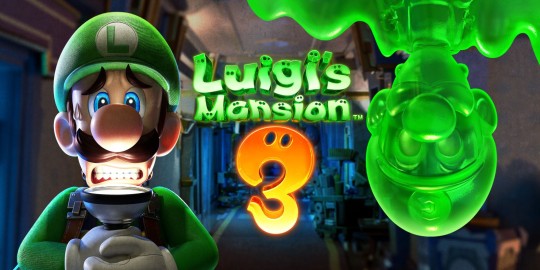
The GameCube was an odd era for Nintendo, as they attempted to innovate and try new ideas rather than rely purely on their old standbys. Case-in-point, rather than launch the console with a new Mario platformer, his second-banana brother Luigi got his first starring role in what would become the Luigi’s Mansion series. While not making QUITE as big of a splash as maybe Nintendo hoped, it’s garnered a decent fanbase, and when a sequel was announced for 3DS, people ate it up. Considering the gap between the first and second games, I think many people were surprised at the relatively quick turn-around for the third installment. I was also surprised at the overall quality and how much I enjoyed digging into it. For starters, Luigi’s Mansion 3 is easily one of the better-looking Switch titles, boasting some great lighting and particle effects, with some fun physics implemented for just about everything in the massive mansion. Luigi and company are animated with a lot of expressiveness that never gets old, and the music sets the tone perfectly too. From a gameplay standpoint, the toolset Luigi gains gives him ample options to poke at every nook and cranny, with the slimy doppelganger Gooigi being the clear stand-out. Some of the floors of the Last Resort hotel that Luigi must ascend are particularly massive and intricate too, some floors feeling like Legend of Zelda-style dungeons. While not a particularly challenging game, it’s still really satisfying to poke and prod at everything in sight, sucking in all the coins, gold bars and stacks of paper bills you can handle, not to mention slamming the ghosts around like the Hulk does to Loki. There’s also multiplayer! That I…haven’t really touched but…hey! More bang for your buck, surely!
#3 – Dragon Quest XI S

I don’t consider myself a huge fan of JRPGs. Or at least that’s what I thought before I tried out the Dragon Quest XI demo on Switch. I ended up falling for the game hard and bought the full release, carrying my demo data over and not stopping until I hit credits. Despite having never touched a Dragon Quest game before, outside of an hour or so of VIII, I was overcome with this feeling of nostalgia when it came to this game. That’s because Dragon Quest is THE quintessential JRPG game, the originator of all that we take for granted today. It was nice to feel right at home with a simple, effective combat system, rather than having to watch games re-invent the wheel in an attempt to stand out from the pack (sorry Xenoblade), and the story itself, while predictable and a little basic at times, was told well and told earnestly. It really nailed the feeling of going on a grand adventure, with enough twists on the formula to keep things interesting. The turn-based combat was elementary, but always presented me with fair challenges and lots of ways to solve the encounters laid before me, with enough quality-of-life features added in to minimize grind and make things more convenient. The Switch version of Dragon Quest XI featured a bunch of new content on top of a game that had more than enough going for it, and it’s clear a lot of work was done to make this port as faithful as could be, and it stands out not just as a great port on a system known for some shoddy ones, but as a title that’s brimming with as much polish and quality to rival first-party Switch titles. Don’t ban Hero in Smash and don’t miss out on this game if you haven’t taken the plunge already!
#2 – Devil May Cry 5
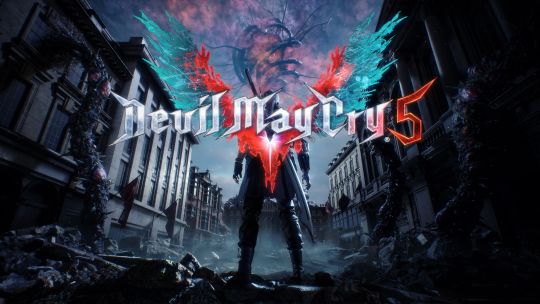
The Devil May Cry franchise has had its share of ups and downs over the years. For every game that’s considered a success, you have another game that doesn’t quite measure up. For years many thought the franchise was dead in the water after the attempted reboot, DMC: Devil May Cry failed to grow its audience, but when Microsoft’s E3 2018 show revealed to us a new installment, fans were ecstatic. Devil May Cry 5 boasts crisp visuals, deep combat and trims the fat, removing the wonky platforming and puzzles of earlier games to create a high-octane action experience that ultimately exceeded fan expectations. Its storyline firmly plants Devil May Cry 4’s Nero as a main character in his own right, wraps up the story of the Sparda brothers neatly, and if this ended up being the last title in the series, I think it’s that rare ending that ends up being totally satisfying. Combat is the real draw here though, the game giving players three distinct characters to learn and master. Nero’s robotic Devil Breaker arms allow him a decent amount of variety, while having a balanced, beginner-friendly combat style for new players. Dante remains the king of variety, having more weapons than ever before combined with his signature style switching, though the game is actually designed with all these options in mind so he doesn’t end up breaking the game like he did in 4. Newcomer V ends up being a breath of fresh air, controlling up to three demonic summons at once, forcing players to really think more strategically. The music is incredible too; Nero’s own theme, Devil Trigger, has been stuck in my head since last year and I don’t see it leaving any time soon. All things considered, Devil May Cry 5 might be the best game in the franchise, and a worthy contender for game of the year personally. Now if only we had a special edition with Vergil and the ladies playable…
#1 - Fire Emblem: Three Houses
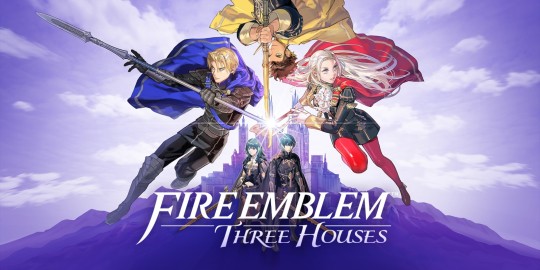
I got into the Fire Emblem series with Awakening and really liked it a lot, however Fates, the next installment, left a bad taste in my mouth. I couldn’t really get into Echoes, itself a remake of the second game in the series, and I began to wonder if this franchise was really for me. I was willing to give Three Houses a shot, but I was not prepared for the game to blow past all my expectations. Fire Emblem: Three Houses isn’t just a good game, it’s a game that’s redeemed a franchise that’s stumbled a bit in recent years, and it likely cements Fire Emblem as a core Nintendo franchise for years to come. It has class, depth and real heart...with only minor creepy or pervy elements! Making a grand return to home consoles after more than a decade on handhelds, it goes big and it ultimately paid off, on track to become the best-selling entry in the series. The school setting might seem weird at first, and I wondered how well I’d adjust to it, but being able to instruct your units and influence their growth in battle was worth the learning curve. Things are introduced slowly enough that the flow of the game becomes relatively easy to manage, if a bit time-consuming overall. With four distinct storylines you can explore, TONS of character interactions and some interesting tweaks to the strategic gameplay the series is known for, I’m confident in saying that Three Houses is well-worth a purchase for newcomers to the franchise. Divine Pulse is a great quality-of-life addition that lets you undo mistakes, rather than force you to start over from scratch, and overall the UI and layout of the game gives you enough information to make informed decisions without overwhelming you. Makes me wonder how we survived before the games showed us who enemies would target on their turns before now. Admittedly, some aspects of the progression have some issues, especially at endgame, and visually the game really is not up to par most of the time, but these end up being tiny blemishes in the long run for me. They certainly weren’t bad enough to prevent me from starting a new path the instant I finished my first route. If I have one request…just make Claude a gay option. Give the people what they want, Nintendo!
Honorable Mentions
I’d like to add on some honorable mentions here before we close things out, though most of these are things I didn’t even get a chance to play, but they certainly might have made this list. For one, Resident Evil 2 Remake seems like a high-quality reinterpretation of the survival-horror classic, but I can’t do horror so I’ll likely pass it up. It’s also for that reason that I might not get to Control but I might try jumping out of my comfort zone for that one. The confusion surrounding both The Other Worlds AND The Outer Wilds is funny, but they’re both space-based games I’d be keen on getting to at some point down the line; the former is a great Western RPG by the folks who made the GOOD Fallout games, while the latter is an interesting space-faring puzzler with some interesting mechanics I’d rather not spoil for those not more in-the-know. Indie titles Sayonara Wild Hearts and GRIS definitely caught my attention with their great visuals, and in the case of the former, its soundtrack, even if the gameplay wasn’t quite there for me, and the weird fighting-game-but-kinda-RPG that is Indivisible demands my attention sooner or later. Bloodstained is the Castlevania follow-up I keep forgetting is out, and I hear great things about Yooka-Laylee and the Impossible Lair. The team behind the Yakuza series recently made a spin-off of sorts, Judgment that hit the West this year and while I like the Yakuza series for its quirky tone and fun combat, there’s still six other games I’d have to sift through, so going with Judgment, which is set to possibly begin a new franchise, seems like a good alternative. And how could I forget the likes of Shovel Knight as we finally receive the last expansion that’s been years in the making? I haven’t touched the King of Cards expansion yet, but I have the upmost faith in anything Yacht Club makes, so that’s surely a game of the year contender. 2019 was crazy good! Glad to close the year out with so much quality, and tons of great stuff to add to the ever-growing backlog.
Hope you had some good gaming memories made this year!
-B
#gameoftheyear#GOTY#GOTY2019#astral chain#lucky's tale#baba is you#river city girls#devil may cry#luigi's mansion 3#katana zero#power rangers#fire emblem three house#dragon quest 11#xb-squaredx
1 note
·
View note
Text
Happy New Year!
Hamuha, Hamuchanzu!
The Ham Ham Paradise’s staff wishes you a happy new year 2019, we hope all your dreams come true and you enjoy yourself this whole year!
Well, well, where to start... I wanted to prepare this post ahead of time, but alas, I had super busy last days of the year and didn’t quite managed to get it done. So I’m just improvising.
Surprisingly enough, although it was the year after Hamtaro’s 20th anniversary, this year has been way more active for the series than the last 10. Japan give us a new website, an actual interview with Kawaii-sensei, an art contest, a themed cafe and even New Year’s charms. Honestly my hopes are super high in regards a reboot of the series but we don’t want to feed false expectations.
At Paradise Hamsubs however, we have failed to keep our promise of 2 episodes monthly. That was a long shot!
Paradise Hamsubs started a Patreon and a Ko-fi last year, and we thank our patrons for their support. This year, we aim to work on even more stuff. We can’t quite promise 24 episodes a year, but we do plan to work in Hamtaro and other shows. For instance, I’d like to announce that Paradise Hamsubs will be subbing Jewelpet Sunshine in the near future. More information regarding that later on.
Regarding Ham Ham Paradise, as promised, the website is up and running. You can visit http://www.hamhamparadise.com and get a look at the old layout! I want to note that many old sections are currently only readable in plain text, and some are missing. Files are super old too, so many links may (or will) be down or outdated with older versions of the files. We will work hard to fix this as soon as possible, but give us some time!
You may have noticed that we have already posted today’s birthday posts, and that they are quite different from the previous ones. Starting today, all birthday posts will be completely remade from scratch! We will try to follow a script for them that we may improve in time, but for now we’re quite happy with the result. We hope you are too!
I think this covers pretty much all I wanted to share for New Year’s, so once more, I wish you all a Happy New Year! May this be the Hamtaro Year!
Matta ne~
16 notes
·
View notes
Note
You mentioned Sega may have tried to buy better review scores for Sonic '06, and mentioned there was one magazine where that likely did happen. What was the magazine, and how much did they adjust their review of Sonic '06?
The magazine in question was Play Magazine, run by Dave Halverson. For those of you who don’t know who that is, Dave founded GameFan Magazine back in the day. It started as a fanzine/catalog for the “Game Club” store he ran with friends, but the review blurbs and side coverage they began to add to the catalog eventually gained enough traction that they spun it off in to a professionally distributed magazine.
The “Game Club” store sold a lot of import games, and GameFan’s focus on games that would never come to America (or would release in significantly different forms) is what gave it an advantage over its competition. They were also one of the first publications in North America to really start talking about Japanese anime, right at the dawn of the big anime boom in the mid 90′s. For a hot minute, GameFan was in the right place at the right time.

Despite this, GameFan always kept a kind of “indie charm.” Page layouts were messy, cover art frequently was done by fan artists, etc. It had all the positives and negatives of being “the last true enthusiast magazine.” It was passionate but often unprofessional. One time, racial slurs were published in the magazine because they were apparently used as “filler text” that never got removed.
The publication suffered a lot of financial strife. The magazine was expensive to produce (it was printed on higher quality materials than most), and advertising dollars were starting to dry up. On top of that, it was apparently haunted by legal problems; Wikipedia isn’t specific, but it sounds like the investors that helped launch the magazine never got paid back, and sued for damages. All of these factors combined ended up bankrupting GameFan.
After leaving GameFan, Halverson picked up at a short-lived gaming magazine called Gamer’s Republic, which also quickly folded. Halverson then used his connections to hire former coworkers from both GameFan and GR to form Play Magazine.

Dave Halverson earned a reputation for being a certain type of character. He went against the grain a lot. He was loud, dumb and frequently patted himself on the back for being such a hero for writing about video games. There are many cited examples on his Wikipedia page. A good collection of colorful quotes from his various reviews can be found at GameSetWatch.
When Sonic 06 came out, Dave himself personally reviewed the Xbox 360 version and gave it a surprising 9.5 out of 10, a nearly perfect score.
Play Magazine obviously stood alone in this praise.
As you can imagine, some called shenanigans. This was only a few months before Jeff Gerstmann would be fired from Gamespot over saying harsh things about a game tied to an advertising partner, so we were smack in the middle of the early days of game press distrust. For Play to be such an outlier was definitely suspicious and it got a lot of people talking about Halverson and his credibility.
The very next month, Play issued a correction for their Sonic 06 review, clearly feeling the heat: the 9.5 out of 10 was dropped to 8.5. The bees only buzzed louder. Something WAS going on.
Two or three months later, the Playstation 3 version came out, Halverson once again took review duties, and this time savaged it. He gave it like a 6 out of 10. It’s harder to find an archive of this given most review aggregate sites did not archive his PS3 review, but as I recall, he straight up admitted that Sega promised them “the problems would be fixed” and his review score for the PS3 was to reflect that they had not.
(It was still higher than most.)
What this means is that, at the bare minimum, Dave Halverson either:
Wrote a review for a game he did not actually play and just toed the line for Sega.
Played the game, but unrealistically fudged the review score at Sega’s request.
Either way, it probably wasn’t honest.
And it wasn’t even the only instance of Dave Halverson unrealistically heaping praise on to a Sega game that was generally considered mediocre by the rest of the press. Most famously, he went to bat for the abysmal Golden Axe: Beast Rider in 2008, even going so far as to call out other game critics for “sucking” at the game (among other things).
It definitely seems that at some point he had a deal with them, officially or unofficially.
Play Magazine did not survive 2009. Halverson tried to reboot GameFan magazine in 2010, but it limped along, only producing 11 issues in its five year publication run.
The moment the rebooted GameFan disappeared, so too did Dave Halverson. He hasn’t been heard from or seen since.
#questions#sonic the hedgehog#sega#sonic team#sonic 2006#dave halverson#play magazine#gamefan magazine#gamer's republic#review scores#raceprouk
18 notes
·
View notes
Text
Oh, Joy! The Insanely Amazing Art of Animation Cartooning in Ren & Stimpy
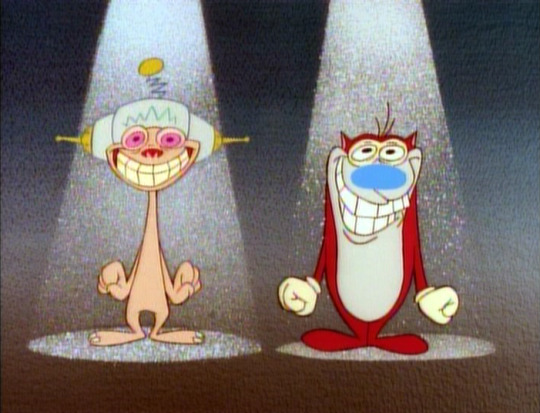
In the era and world of the “modern” cartoon, there’s one show that started and defined most of the cartoons that we watch today... and that show is Spümcø’s/s The Ren & Stimpy Show.
What is there to love about a crazy, wacky, gross, dark and violent cartoon that people say is “ground-breaking”?
The gags. The detail. The sound. The stock music. The design. The animation. The layout artists...
I could go on about a show that was a part of @nickanimation’s/@nickelodeon... although, while considered a “kids” show, it truly is one of those... “cartoons for MEN”.
WARNING FOR HATERS: Before I go on, in regards to the show’s controversial creator, If his wrongs cause you to think hatefully of him, AVOID THIS POST! Don’t associate your hate with my posts and tweets about this ground-breaking cartoon.
Anyway, let’s look deep into the magic of the wackiest cartoon ever created that changed animation--namely “Western” animation--forever and for good...


THE TALENT
Under the creators Lynne Naylor-Reccardi, Jim Gomez, Felix Forte, and controversial creator John K., many gifted artists were a part of this amazing series, including @donshank, Charlie Bean, Carey Yost, Bob Camp, Chris Savino, @stephendestefano, the late and great Chris Reccardi (I began this article prior to his death on May 2nd, 2019 A.D.), Marc Perry, Mr. Lawrence (the “Ooh! My leg! My leg...” guy), Vincent Waller, Donovan Cook, Larry Murphy, Richard Pursel, @gadworks, @ncrossanimation, and many others. These people, many of whom were in the layout department, would go on from Spümcø to work on some of the most popular pieces of “Western” animation in history, like Spongebob Squarepants, The Powerpuff Girls, Samurai Jack, Dexter’s Laboratory, Star vs. the Forces of Evil, Mickey Mouse (Paul Rudish era), The Incredibles, the also ground-breaking The 2 Stupid Dogs/Super Secret Secret Squirrel Show and so much more!
One thing to note about these creatives is that John K.’s production company, Spümcø, was based in Canada, and so were its staff and creatives. I note this as most Canadian cartoons these days have no creatives who work in popular American animation (save for Wild Kratts character designer Alan Stewart, who did character design for some Season 7--or, in “reboot terms”, season 2--episodes of The Powerpuff Girls, as well as Lauren Faust’s My Little Pony: Friendship is Magic and Season 1 of Johnny Test). Most Canadian cartoons these days are on PBS or Cartoon Network, and some of those are imported from Teletoon or YTV. Such Canadian cartoons as Total Drama’s franchise, The Adventures of Benjamin Bear, My Pet Goldfish is Evil, and the like don’t have creatives who work on more “American” media.
Certain talents of Ren & Stimpy included Michael Fontanelli, Charlie Bean, Vincent Waller and Eddie Fitzgerald (creator of CN’s Tales of Worm Paranoia), who went on to contribute their artist talents in the YouTube Poop-phenomenon Adventures of Sonic the Hedgehog, which somewhat resembles that art direction of The Ren & Stimpy Show. Such talents also contributed to another insane-looking cartoon, Film Roman’s The Twisted Tales of Felix the Cat. Likewise, one of my favorite character designers, Carey Yost, who contributed to The Powerpuff Girls, Uncle Grandpa and Spongebob Squarepants, was a major layout artist on this show. Charlie Bean (Samurai Jack, The Powerpuff Girls, The Twisted Tales of Felix the Cat, Adventures of Sonic the Hedgehog) and Don Shank (most of the above, plus Sym-Bionic Titan) also served as layout artists, and they with Carey created a gem of a Cartoon Network Minisode, Buy One, Get One Free*, which reflects the animation and art of Spümcø and features creatives of Spümcø.
THE DETAILS
First thing to note in both art and animation is the barrier-breaking levels of exaggeration. The “wild take” is a common element to slapstick cartoons like The Ren & Stimpy Show, and the controversial creator was a part of Hanna-Barbera Cartoons (which developed the Cartoon Network and its studios). Many Spümcø creatives would work at H-B, too. Hanna-Barbera, who worked with animation legends like Tex Avery, would create some of the wildest takes in cartoons with A Pup Named Scooby-Doo!, but The Ren & Stimpy Show’s Season 2 opener “In The Army”, written & directed by Bob Camp, features what is probably the wildest wild take ever conceived by man in the history of history:

“You don’t want to anger that big, dopey...”

“...sar...”
*( Sound Ideas, BOING, CARTOON - FLAT JEWS HARP BOING )*

*clink!*
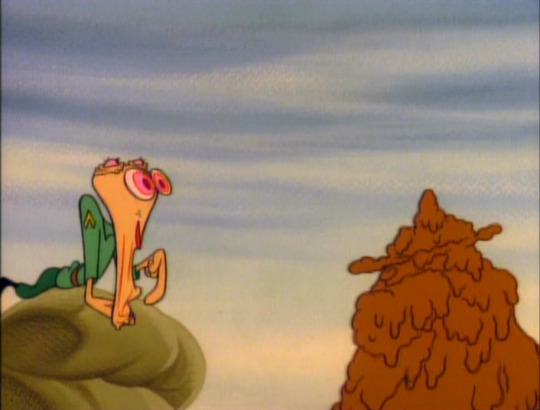
*( Sound Ideas, THUMP, CARTOON - TUBE THUNK 01 )* [+12 pitch]

*glass breaks*

*( Sound Ideas, WOBBLE, CARTOON - SAW BLADE WOBBLE, MEDIUM )*

This wild take is really slow, huh?
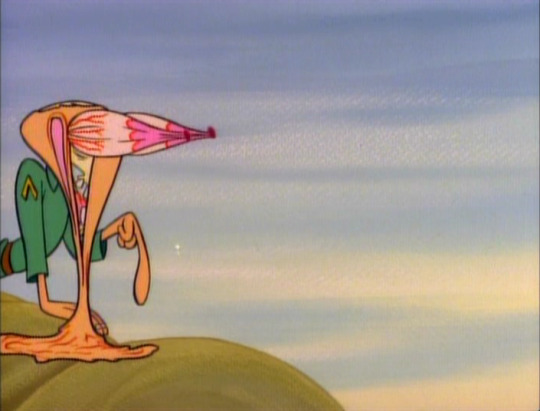
Wait for it...
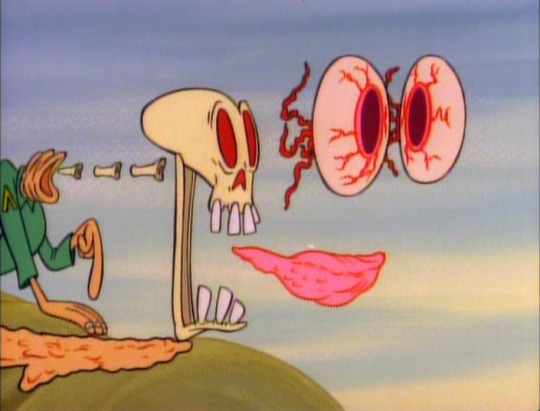
“GYAAAAAAAAAAAAH!”

As if that weren’t wild enough, his brain pops out of his skull! Now, that’s more than just icing on the cake... it’s GENIUS!

Teen Titans GO! is perhaps the peak in the evolution of the “modern” cartoon that began with Ren & Stimpy, and in the hands of producer/director Luke Cormican, a layout artist on Ren & Stimpy’s “Adult Party Cartoon” episodes. It’s very nice that, in TTG episode “The Streak (Part 2)”, there was the parody illustration of duos in media, comparing Robin to Ren and Beast Boy to Stimpy. Some of the character designers on TTG worked on shows that included creatives from The Ren & Stimpy Show, too, namely Chris Battle.
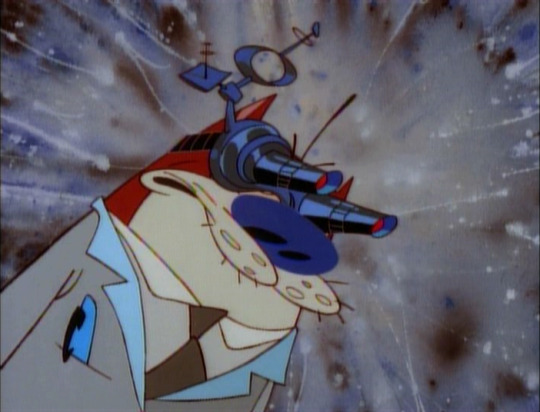
One of the most popular episodes, of course, is the season one finale, Stimpy’s Invention.
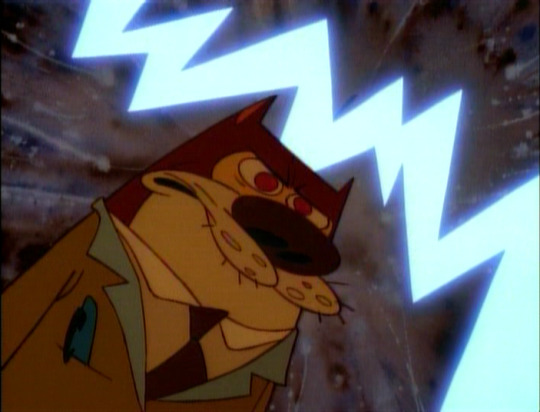

These shots from the scene of Stimpy attempting to invent something are just beautiful! Great attention to detail and the lighting (including effects design) give a very cinematic, theatrical feel to a mere, 11-minute episode of a TV show. The art of the series has the charm of a 1940′s Paramount/Famous Studios “Noveltoon”, the Bob Clampett-directed Merry Melodies/Looney Tunes shorts (a major inspiration for John K.), and the Saturday morning cartoons of the 1960s, and the show’s creatives would become part of certain modern cartoons in the 1990s, some of which were dubbed by @cartoonnetwork as “Cartoon Cartoons”.

Also cinematic to the quality is the authentic film grain, a result of recording the cels (animated frame by frame on their respective backgrounds) on film. The deterioration of the episode’s film masters make it look believably like something out of the 1960s or even The Golden Age of Hollywood, the 1940s! (I personally dislike the quality that the videotape masters add to the picture, though. It may be that, in the future, UHD / HD prints could use the actual film masters, though!)
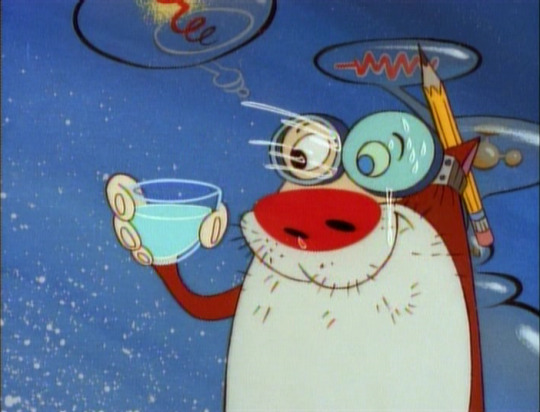
Some shots of Stimpy in Stimpy’s Invention have a color mistake where, like in the title card of the pilot “Big House Blues”, Stimpy’s nose is red instead of blue. It looks pretty swell on him, though.
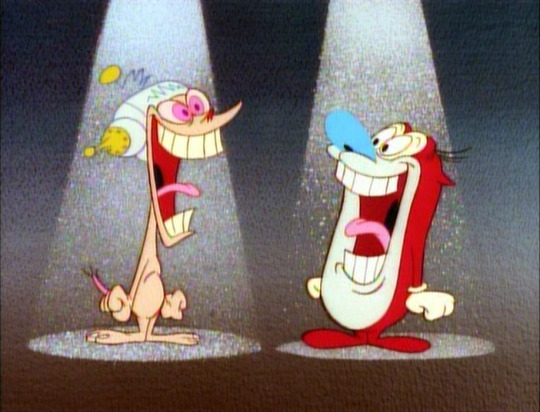

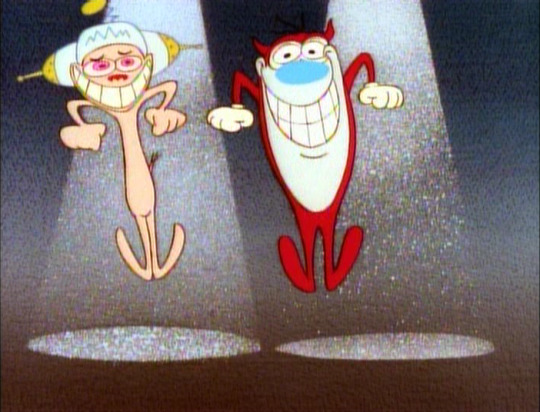
The grooves and moves that Ren & Stimpy make during the montage of the song Happy Happy Joy Joy are filled with bouncy, weight-distributing pieces of animation, with lots of squash and stretch.

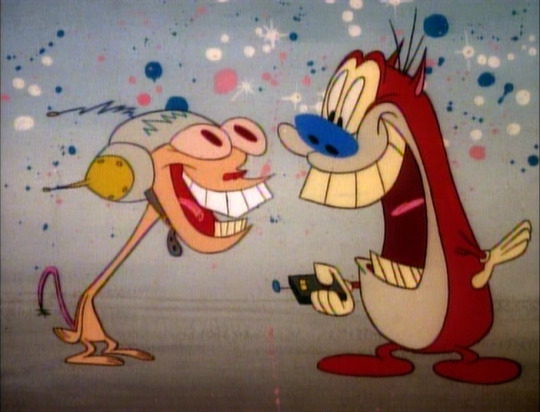
Speaking of “squash and stretch”, the above pics are of the extremes as Stimpy does a take of joy when he succeeds at making Ren be happy.

The takes of the characters really stretch their design and animation. Aurally, a common sound effect to accent these takes is a quick, loud record scratch, and their shaking/trembling movements often sound like a record rapidly skipping.
Regarding one of my favorite character designers, much of the designs by @cheyennecurtisart and @lynnvwang in early episodes of Disney’s Star vs. the Forces of Evil (particularly “Brittney’s Party”) are highly graphic and detailed, and that work of hers reminds me of the designs by Chris & Lynne Reccardi, Jim Smith, John K. and others. Very similar are the designs of @stephendestefano on Disney’s Mickey Mouse, which are also very graphic and extreme with character takes and injury aftermaths.

In the infamous Happy Happy Joy Joy sequence in “Stimpy’s Invention”, to stop himself from being controlled by the Happy Helmet, Ren whacks it (and thus himself) with a hammer to break it..
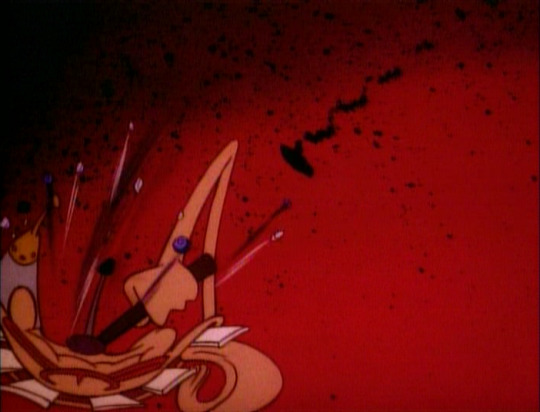
...and every hit pushes the extremes of not only the looks of his body, but also the styles of the psychotic-looking backgrounds.
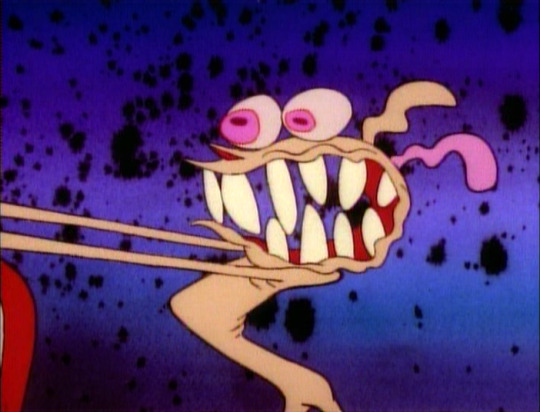
Often in the show is a lot of mental breakdowns, including the end of Stimpy’s Invention as Ren goes from being the angriest he ever was in his entire life...
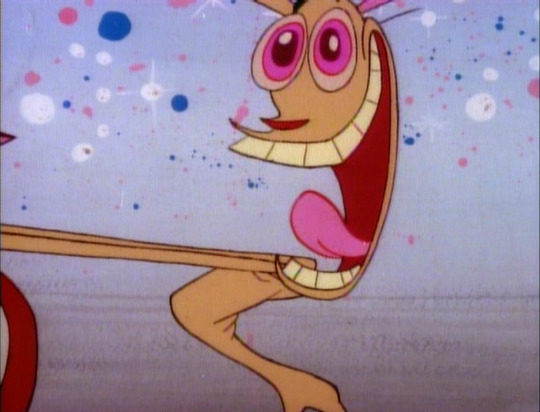
...to becoming very jovial as he comes to love being angry. That also causes a change in these psychedelic, psychotic backgrounds. The practice of such backgrounds came to other cartoons of the 1990s, such as The Shnookums and Meat Funny Cartoon Show, in the episode “Night of the Living Shnookums”, with art direction by Lynne Naylor.
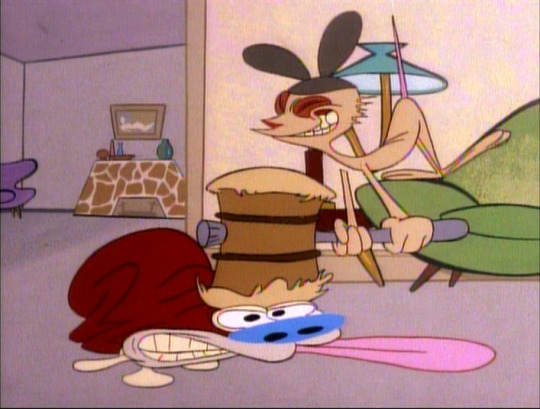
Another great episode, one of my favorites, is “The Boy Who Cried Rat!”, directed by Vincent Waller, who, replying to my tweet compliment, described the episode as “a chance to tip the hat to all the amazing cartoonist/ writer/ funny people who took the time to invest theirselves into their artwork for the enjoyment and tutelage of the regular folks and cartoonists to come.” The episode involves a literal game of “Cat and Mouse” and Stimpy tries to make a living for him and Ren by unleashing his inner cat in service to a couple. It probably bases itself, of course, on Tom and Jerry, and Ren’s costume references the fashion of Mickey Mouse.
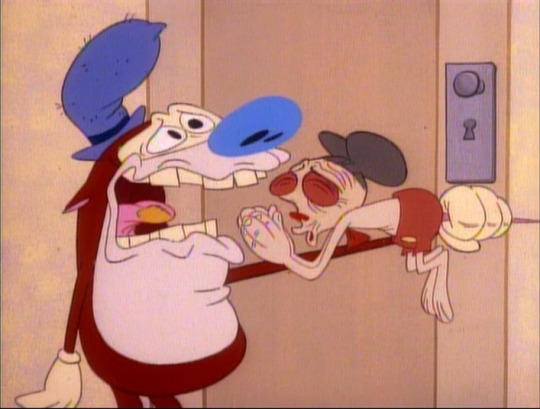
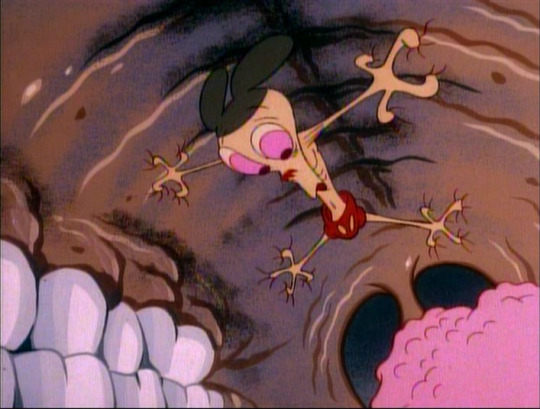
Eventually, Stimpy is forced into eating the rat whom Ren plays (this reminds me of another classic cartoon, @paramountpictures’s Noveltoon called Cheese Burglar, featuring Herman and Katnip). In terms of cartoon physics, though, how did Ren become small enough to fit inside Stimpy’s mouth?

This episode features a very clever, unexpected visual gag that is the result of being hit with a frying pan.
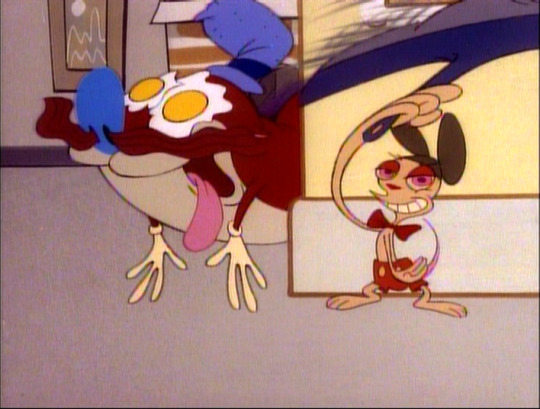
See? and it’s not even a violent image, either.
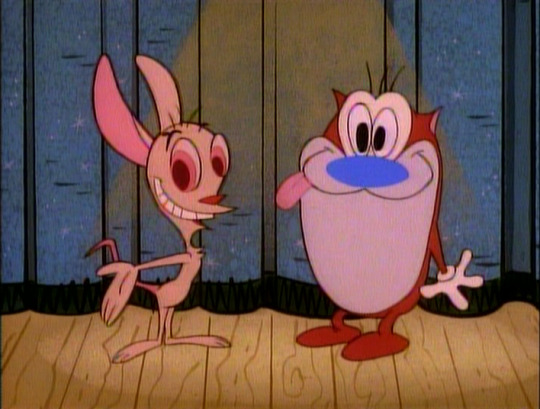
Sometimes, the show would feature various segments among the episodes, including their close-out segment “What’ll We Do ‘Til Then”. The Ren & Stimpy Show actually predates Animaniacs (1993), VeggieTales (1993) and Uncle Granpda (2013), which were similar with a variety of segment material.
THE ANIMATION
The animation is certainly something when one considers the defining quality of this show’s animation, which occasionally was produced by Rough Draft Studios in Seoul, Korea, one of the most popular animation studios today. There’s also some great timing directors, like David Feiss (Cow and Chicken, I Am Weasel, All Dogs Go to Heaven 2, The Grim Adventures of Billy & Mandy), Bob Jacques, James Tim Walker (Samurai Jack, The Powerpuff Girls, Tom and Jerry: The Magic Ring), Kent Butterworth (Adventures of Sonic the Hedgehog) and even the awesome Tony Fucile (Osmosis Jones, The Iron Giant, Tom and Jerry: The Movie, Inside Out, The Little Mermaid), who was uncredited for a few episodes like “In The Army” and “Ren’s Toothache”).
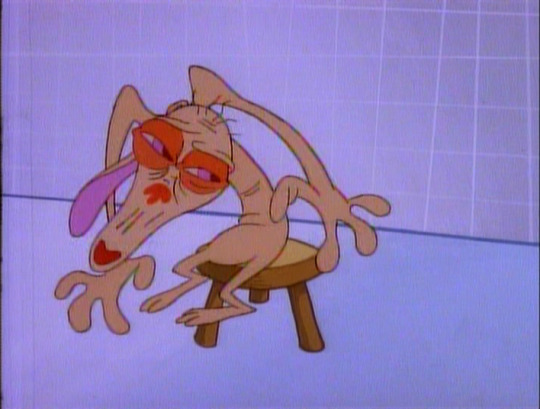
This scene of animation from the episode “Nurse Stimpy” (frame shown above) is one of the very best pieces of animation ever done in the series. The balance between slow and mostly fast-paced animation/timing, along with weight, looks very cinematic--of theatrical-quality animation (like Don Bluth, Tony Fucile, etc.). The film’s quality is fairly deteriorated here, but film specks and stuff add to the cinematic feel.
THE SOUND
The sound design, of course, done at Horta Editorial and Sound, which became/folded into Hacienda Post at Sabre Media Studios, was also defining for the modern cartoon as an unusual array of sound effects were used to accent all sorts of takes, impacts, etc. The use of Hanna-Barbera & Warner Bros. sound effects (mostly available from Sound Ideas) with Disney sound effects (mostly available from Hollywood Edge’s Cartoon Trax Volume One) became a very common blend for many sound designers, up to today. Hacienda Post’s founder and president, Timothy J. Borquez (Spongebob Squarepants, Samurai Jack, The Powerpuff Girls), served as the Re-Recording Mixer and Supervising Editor, as well as the uncredited sound designer, and considers the groundbreaking show to be “a laboratory for using classic sounds (in different contextual situations); adding Foley and new design to create "hybrid" textures and moments. We conscientiously did this and it opened up a whole new world for us! A lot of this was done on the mix stage.” He worked with talented sound editors like Michael M. Geisler, M.P.S.E., Michael A. Gollom, and sound/music editor William B. Griggs. Speaking of cartoon sound design expert Michael M. Geisler, M.P.S.E., in an Animation World Network article, Michael Geisler described the detailed process of sound design in a moment of the controversially violent scene in “Man’s Best Friend” (which never showed the credits): “Sometimes the eyelid closing and the eyelid opening are two very separate actions, and so each motion, open and close, must have different sound effects. In "Man's Best Friend," the classic Ren & Stimpy episode that introduces George Liquor, Ren smacks George with his own "Prize Bludgeoning Oar" and George's eye pops out of his head like a piece of meat. The eyelid does a wet sounding movement down over the eye until the eyelids meet and blink (splat, wet hit), and then slosh up again.” For some reason, however, on prints of that episode, George’s blink is silent.
The music for the show was usually unoriginal, very much like the series soundtrack to Spongebob, as it was mostly composed of music provided by Associated Production Music (APM). This included classical music, too, just as Tom and Jerry, Disney’s Silly Symphonies and Warner Bros.’ Merry Melodies/Looney Tunes would often use. Someone even created 3 volumes of Production Music from Ren & Stimpy, unofficial collections of APM music from the series. I kind of wish that they made those.
You may wonder at this point: After many years of seeing almost nothing of this series, how found I The Ren & Stimpy Show in my life?
I knew or remember very little of the show as I grew up (at least attempting to watch the episode “Ren’s Pecs” one Sunday afternoon in 2007 on Nick), but on August 13th, 2016 I saw another Spümcø project, the later Yogi Bear (or Ranger Smith) episode “Boo Boo Runs Wild”, on @adultswim. John K.’s approach to a classic Hanna-Barbera cartoon (CN doesn’t even air this stuff on anymore) was very inspiring. Looking the names of the team up on IMDb, I found that they were a part of many amazing cartoons that i grew up watching! In May 2017, recommended on my YouTube user were “disturbing” scenes from The Ren & Stimpy Show, including Ren’s insane threats in Sven Höek (the audio of which I heard in a YTP where the King [of Hyrule] goes psycho and does the same menacing threats) and perhaps a spiritual taste of Hell in Stimpy’s Fan Club. Ren’s acting (voiced then by creator John K) was so hilarious that, from that point onward, I desired to see more of this groundbreaking cartoon on which I was missing out.
On the day that I began to concept this post, June 18th, 2018, in my final visit to Toys ‘R Us (a local one, though I remember visiting the New York one in 2001), I got collectible Ren & Stimpy figures, and at the time of this post’s original concept I placed Ren and Stimpy in the presence of my Aku wacky wobbler.
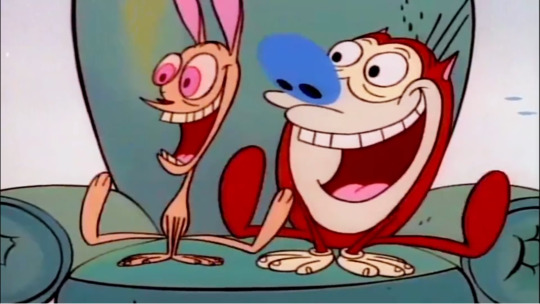
It’s interesting that a 2018 Google spot regarding how children react to crowd noise used an excerpt from the episode Stimpy’s Fan Club. This practice is like certain phone commercials (namely T-Mobile, I think) that use some brief footage from “public domain” cartoons. Likewise, what Google did with that ad makes The Ren & Stimpy Show feel like a public domain cartoon (and the highly famous Merry Melodies/Looney Tunes and Popeye shorts were often distributed as “public domain” too, though WarnerMedia holds the ultimate rights to the shorts).
From a Christian viewpoint, The Ren & Stimpy Show is sometimes controversial, but its biggest controversy is whether it’s really a kids show or not--perhaps more of an adult show--mostly due to violence and intense situations like the aforementioned mental breakdowns (this excludes the “Adult Party Cartoon” episodes as those were deliberately produced for adults). Of course, classic cartoons of MGM, Warner Bros. and other studios would often show violence, sensuality, smoking, and alcoholics (even though Cartoon Network/Boomerang still rates them “TV-G”), so even those weren’t produced completely with children in mind. That’s why I consider this show and the aforementioned classic cartoons as “cartoons for MEN”.
The humor and heart of The Ren & Stimpy Show isn’t the purest either, given all of Ren’s hate and violent anger, but Stimpy’s Fan Club has an actually touching ending: after attempting to kill Stimpy or otherwise at least upset him, Ren discovers that the one fan letter addressed to him was from no one else but Stimpy himself--and Stimpy meant every word in his letter. Then, Ren is broken to tears.
THE FUTURE?
As a devote cartoon-watching guy, I find great inspiration from the barrier-breaking art and animation, visually and aurally, of The Ren & Stimpy Show. If you love slapstick comedy and cartoons, then this one’s definitely worth a watch--essential viewing. I surely hope that it comes back again; I can agree on one’s opinion for the show to come back (and, if you want the show to be rebooted as I do, share this IMDb list with Nickelodeon/Spümcø or whatever studio’s in charge). Now, if Viacom/Nick is willing, [adult swim]/Turner/WarnerMedia or some other studio may be better off to purchase the rights to Ren & Stimpy, as Nick or at least Paramount no longer wants anything to do with the series (due to the objectionable material in the “Adult Party Cartoon”), according to this article.
There were rumors of an upcoming Ren & Stimpy short that Nickelodeon Animation was producing. IMDb once removed the title, but now the short “It’s Our House Now!” may be in production by Jessica Borutski, also a former layout artist on the “Adult Party Cartoon”; this may be based on a short John K. sketched to promote Sponge Out of Water.
The closest thing to Ren & Stimpy so far is John K.’s Cans with out Labels [WARNING: some strong language and nudity], a dark, edgy Kickstarter short featuring George Liquor, including storyboards & layouts by Jim Smith and amazingly cartoonish, detailed, over-the-top animation, contributed by @gadworks, @mikepelensky and @sandrarivasart (a DVD is available for $25 purchase here). Color cards were made by @kalikazoo too.
In the future, also, it would be swell to see true high-definition transfers of the actual film negatives for the non-digitally animated episodes of Ren & Stimpy. Most filmed cartoons were often recorded onto videotape masters, which lowered the quality, and I suppose that some of the film negatives still exist in Spumco’s/Nickelodeon’s archives. In point of fact, this clip of The Muddy Mudskipper Intro here looks like it came from an actual film negative (of which I tweeted), with brighter colors and no videotape quality. Though the film looks fairly aged, it looks better than usual prints of the scene.
As we come to the conclusion, I have some additional notes: I began this post in January 2019. 5 months later, Chris Reccardi died, so I refer to him in my posts as the Late and Great Chris Reccardi. He and his family are in my thoughts and prayers. A documentary premiered at Sundance 2020 on January 28th, 2020, Ron Cicero’s Happy Happy Joy Joy: The Ren & Stimpy Story; while the controversial creator is known for some terrible things he did due to mental issues in the past, the least people could do is respect the work of both John K and his groundbreaking team. If it weren’t for them, many great Western animation projects for Cartoon Network, Pixar, Disney TVA, Nickelodeon and others would not be the same.
Before I close, whether or not you think negatively of John K., here’s something you should know, understand, and remember about the value of the creatives of The Ren & Stimpy Show: "Brilliant cartoonists like Lynne Naylor, Jim Smith, Bob Camp, Vincent Waller, Rich Pursel, Elinor Blake, Bill Wray, Chris Reccardi, Gabe Swarr and many many more added a lot of richness and personality to the cartoons. Actors like Billy West, Cheryl Chase, Mike Pataki, Gary Owens, Eric Bauza and others inspired us all to capture the subtle nuances in their readings. Henry Porch, Bill Griggs and Tim Borquez contributed much to the wacky new sound design style Ren and Stimpy was known for. We also had some very talented producers like Chris Danzo, Libby Simon and Kevin Kolde who helped me execute the totally new production system that gave the artists ways to express themselves more personally. These people and more are all heroes to me. Think of them when you remember my cartoons." I will always think of these people and pray for them.
For the inspiration, I give thanks to the entire Spümcø staff and creatives who went on to produce some of the best cartoons ever made.
#ren & stimpy#ren and stimpy#the ren & stimpy show#the ren and stimpy show#cartoon#cartoons#animation#spumco#cartoon network studios#hanna-barbera cartoons#inspiration#inspiring#nickelodeon#chris reccardi#billy west#tony fucile#bob camp#bob jacques#happy happy joy joy#classic cartoon#classic cartoons#wild take#wild takes#detail#funniest friday#funniest friday ever#nicktoons#charlie bean#carey yost#john kricfalusi
8 notes
·
View notes
Text




MAGGIE VERA – packs
── 𝙄𝙛 𝙮𝙤𝙪 𝙪𝙨𝙚: 𝙡𝙞𝙠𝙚/𝙧𝙚𝙗𝙡𝙤𝙜
── don’t clame as your own.
©: @. caotichuman
(𝒄𝒓𝒆𝒅𝒊𝒕𝒔 𝒊𝒏 𝒕𝒘𝒊𝒕𝒕𝒆𝒓)
#layouts#icons#headers#charmed#charmed reboot#charmed remake#charmed reboot icons#maggie vera#maggie vera headers#maggie vera icons#maggie vera layouts#sarah jeffery layouts#sarah jeffery headers#sarah jeffery icons#sarah jeffery
16 notes
·
View notes
Text
Liver disease C.
I travel a great deal as well as i know that is actually everything about holding your horses. Relating to total CapEx, we devoted $118.1 million in the 4th one-fourth, consisting of $18.7 million on brand new builds and $99.4 thousand on existing cinemas. Available on Internet Repository as well as Open Public library (Digitizing sponsor: MSN; Book contributor: Kelly Collection, Educational Institution from Toronto). Every now and then a Pisces woman will certainly cover her shyness as well as susceptability along with antics, an innovative veneer and a chilly independent personality, however it's merely a cape from protection, put on to hide her anxiety off the spying eyes from rough folks which will wound her genfle heart if she exposed this. I recognize one that decants her genuine heart through creating charming track lyrics with a secret message woven in the tones of her soft, quite private desires.

Psychological science Today's Sherrie Bourg Carter points out, Taking time for yourself gives your brain an odds to reboot, enhances attention, increases efficiency, assists you uncover (or even rediscover) your personal representation, gives you a possibility to meditate, and also assists you problem-solve more effectively." Upcoming opportunity you feel bogged down with life, take a little bit of break from the turmoil. Could read online at Church in Past, part 1, component 2, part 3 (link gotten by means of Wikipedia admittance James Joseph Walsh"). Welcome to the LSC Communications' 4th Quarter 2017 Revenues Contact. ( „ What performs the Catholic Congregation teach involving the regard forever?). While there are actually absolutely times that I seem like every person around the world is actually watching me, I have actually never ever truly had anyone beginning controling to me what my lifestyle should feel like, what religion tasks I must reside in, what I must be actually wearing, how I need to be investing my money, and so on Also girls who might di3ts-colour.info conceive ought to be careful concerning mercury usage because the toxins could stay in the body system for over a year. Accessible in PDF format (17 pages) on this webpage from the Archdiocese from St. Louis N.B., This documentation delivers a very beneficial review from the mentors of the Church on blessed buildings. This is downright rubbish since if MP's know that a private body - after finishing a transparent testimonial from the 10% (which explores the audited audit from playground managers) - then declares that the 10% is certainly not the required revenue fiber without which the web site managers organisation's would go bankrupt; they will have no reasons making any type of add-ons to your pitch charge. Women that are 5 shoes 8 inches high possess ideal body system weights greater than girls from briefer states. Might be downloaded in PDF style off Documenta Catholica Omnia, as well as may be read online at Jacques Maritain Center (N.B., The web link gotten through the Wikipedia access James Joseph Walsh"). My present girlfriend is the affection of my lifestyle and also I could view for good with her, yet only given that she meets me on that particular greater aircraft that I could not begin to explain with terms, where I have been able to let down my protector, definitely be myself and fully allow her in. she recognizes me in a way nobody else could possibly as well as I discover that to become the best emotion I could possibly ever expect to have. I inform 2 tales, one imaginary as well as one real, managing possible behaviors which highlight the tractor pull in between unusual minutes from sharp crisis and typical foreseeable daily lifestyle. Readily available in a variety of layouts at Net Older post and also Open Collection N.B., in TWENTY pages, dealing mostly along with worship of the Fortunate Mother as well as the various other Saints.

" Evangelium Vitae" 5 Years of Conflict along with the Culture: Procedures from Sixth Assembly from the Pontifical Academy for Life, Vatican Urban Area, February 11-14, 2000, revised by Dr. Juan de Dios Bottle Correa and also Elio Cardinal Sgreccia (Vatican Urban Area: Libreria Editrice Vaticana, 2001), accessible in PDF layout (on this web page) from the Pontifical Institute forever N.B., This is actually a compilation of essays who mental market value over-shadows the mistakes of the text.

If she gives you the go-ahead, fantastic - yet don't work out on times when you believe that you're falling victim to an ailment, you are actually particularly painful or have pain or even inflammation, tells the Centers for Health Condition Command and also Protection.
0 notes
Text
Doom Eternal review – the same orgiastic thrills with a creeping weight of story • Eurogamer.net
“Story in a game is like a story in a porn movie,” the original Doom’s programmer John Carmack once wrote. “It’s expected to be there, but it’s not that important.” A connoisseur of sleaze might object that story often makes for sexier porn – after all, story tends to involve chemistry, atmosphere, suspense and all the other emotions that distinguish intimacy from the act of banging together genitals to spark a human being. Still, if we’re going to liken games to pornography, and assuming it’s the more kinetic kind of pornography you’re after, I heartily recommend Doom Eternal: a looping video compilation of oversized guns and fists plunging into squelchy orifices, spurting along at 60 frames a second.
Doom Eternal review
Developer: id Software
Publisher: Bethesda
Platform: Reviewed on PS4
Availability: Out March 20th on PS4, Xbox One and PC, coming later this year to Switch
2016’s accomplished reboot was already quite the debauch, its firefights punctuated by leering close-ups of skewered hellspawn, its heavy metal soundtrack always building to a crescendo. Eternal turns up the heat even further, allowing you to dash and flip your way around arenas that are newly fixated on the vertical axis. Dripping organs are wrenched out of, then stuffed back into, demon torsos; chargeable alt-fires scream for release; health orbs spatter the ramps and chokepoints like – well, you get the picture. The environments often look like the work of an adolescent H.R. Giger who’s just got into AC/DC. Aside from silvery Protoss-ish fortresses and some seriously down-at-heel office blocks, you’ll wander labyrinths of squirming flesh, using runes to unclench toothy sphincters and shearing pop-up tentacles in half with your shotgun.
Some, of course, will soberly insist that all of this is just good, honest, videogame violence – clean, upstanding fun with absolutely no over- or undertones whatsoever. And to these people I say: when I am walking down the shaft of an enormous spear, straight into the pierced belly of a reeling, gaping titan, it is difficult to argue that there isn’t some kind of metaphor in play. “Rip and tear”? More like rip and splooge.
Carmack’s porn quote (which he has since qualified a little) epitomises the view that narrative in games is always an imposition, a foreign body carried over from film and literature. It’s a view that has been roundly debunked. The thing is, though, Eternal does have a story, somewhere in amongst the parade of demon O-faces, and while that story is lightweight by Zenimax game standards, it feels hopelessly grafted on. Having thwarted Hell’s invasion of Mars, the legendary Doom Slayer must purge Earth itself of diabolical interlopers, setting out from a gothic orbital station turned customisation hub to a series of ravaged cities, factories and temples that feel on loan from Gears of War. In the process, he must also tunnel back into a startlingly eventful past, sitting through flashbacks and wrangling with old allies.
The 2016 game was a thrilling reimagining of the speed and ferocity of 90s Doom combat, but it also magnified Doom’s narrative trappings, adding in cutscenes, audio diaries, codex entries and mid-mission dialogue – a curious reversal of one of id’s key decisions with the original game, which was once planned to include a sizeable narrative component written by co-founder Tom Hall. Eternal adds yet more to the load, expanding the cast and redoubling the emphasis on lore.
youtube
The cutscenes are now a mix of first and third-person, which means the Slayer is a fully tangible human being – one you can, moreover, trick out with unlockable outfits and weapon skins – rather than a pair of enormous fists twitching beneath your aiming reticle. He feels enclosed by the fiction, rather than, as Christian Donlan put it back in the day, like a man who is also playing Doom and who shares your resentment for anything that gets in the way. There’s some effort to explain the character’s superhuman prowess, with one scientist suggesting that you represent humanity’s rage to survive, as opposed to humanity’s love of making Cacodemons pop in slow motion. The Slayer even has a voice these days, though I think he strings together maybe five words in total.
True, our man in green never looks happy with all the attention, stomping impatiently through cinematics while other parties monologue at his retreating head (if they’re lucky, that is – the fate of most speaking roles in Eternal is to be ground up like tuna). Nor are you required to listen to the audio diaries, or dip into the codex. But these elements drag on you nonetheless, like the lakes of purple goop that stop you running or jumping in certain levels. They’re a deflating reminder that you are no longer here just to indulge your baser instincts. Conversely, the developer’s guilty awareness that people don’t play Doom for the narrative means that when you do dig into the world-building, you’ll find it to be scanty and by-the-numbers: a set of tired references to ancient races, legendary battles and fallen cities.
Still, if visceral gratification is the goal, Eternal amply delivers. The combat is once again about ceaseless pivoting between attack and retreat, care of a raucous battlefield ecology which sees you ripping ammo, health and armour refills from your prey rather than just searching for medikits or finding somewhere to cool off. Stun a foe and you can execute them for a smidgeon of health. These executions double as windows of rest, with other demons easing off till you’re done rearranging your victim’s anatomy. They can also be triggered from metres away, warping you to the target without even the courtesy of a transitional animation, which means you can use them to escape or get behind a mob. Bisect demons with your trusty chainsaw, meanwhile, and you’ll be rewarded with a geyser of ammo, restocking all your weapons in one dollop. You’ll need plenty of chainsaw fuel to carve up the bigger demons, but you’ll always have enough to carve up the smaller “fodder” demons, who spawn endlessly throughout each battle till the larger demons are slain.
This hyper-aggressive resourcing style forces you to close the gap with foes who are, in any case, very good at running you down. Some, like the minion-summoning Archville, are closer to terrain hazards, but the underworld’s legions are light on snipers or artillery; pretty much everybody, from the podgy Mancubus to the serpentine Whiplash, is hell-bent on getting in your face. It sounds like chaos, and often is, but there’s a lot of science to Eternal’s combat, and solid artistry to how the key variables are conveyed from second to second. Ammo, health and armour drops are colour-coded; staggered enemies flash blue, then orange when they’re about to recover. The game’s audio is similarly readable, once you acclimatise to the roaring heavy metal soundtrack. You’ll learn to follow the progress of the battle by ear – be it the tink of a cooldown gauge, the belch of a Cacodemon that has just swallowed something explosive, teeing it up for an execution, or the nasal howl of a charging Pinky.
New variables include an ice grenade, mapped to the trigger, which lets you flash-freeze whole groups to interrupt otherwise lethal offensives. You can also light foes up with your shoulder flamethrower attachment, causing them to spit out armour parts and further motivating you to fight at close quarters when you’re hurting. The most important change-up, however, is your newfound agility. Besides availing himself of launchpads, the Slayer can now perform aerial dashes, scuttle up laddered surfaces, swing from monkey bars and use a Super Shotgun-mounted grapple line to yank himself towards or past enemies.
This encourages showboating reminiscent of anti-gravity duels in the sadly-forgotten Lawbreakers. You might grapple somebody, fling yourself past them while firing your shotgun pointblank, then double-jump to a monkey bar, hurling yourself at a stunned Pain Elemental, then drop neatly onto a launchpad while switching to your Heavy Assault Rifle so that you can carpet the arena in micro-missiles. The weapons are by and large entertaining rejigs of DOOM 2016’s offerings, with two upgradeable alternate-fires per gun that lend themselves to different tactics and different opponents. Your shotgun, for instance, can serve as either a sticky grenade launcher – useful when trying to shoot the turret off a Cyberdemon – or a buckshot-firing Gatling gun for crowd control.
Inevitably, the charm of Eternal diminishes the further you travel from these firefights. Its grander story component aside, the game is slightly over-burdened with customisation systems. Besides tracking down weapon mods in levels themselves, you’ll equip runes for perks such as slow-mo when you aim in mid-air, together with Praetor Suit upgrades such as the ability to suck in health drops from further away. There’s a knack to combining Rune perks, especially when tackling “Master” versions of levels that have more punishing enemy spawn patterns, but the role-playing systems aren’t novel, and the associated menu-diving bogs down a shooter that’s at its best in the thick of the bloodshed.
What really saps Eternal, however, is the predictable way the campaign once again breaks down into combat bowls and platforming stretches that feel like they’ve been stripped at random from Prince of Persia: Sands of Time. There are collectibles to unearth, some tucked in high alcoves or behind smashable walls, together with optional hidden battle chambers, but the alternation of shoot-out then jumpy bit then shoot-out is the same throughout. Boss battles are the biggest change of tune – the final clash is a doozie, a gruelling two-phase affair in which your nemesis looms over the layout like the world’s angriest D&D player. But some of them are just annoying, a question of repeating a tactic to whittle down a health-bar. It’s revealing that the game offers you a layer of all-but-indestructible Sentinel armour after a certain number of deaths, though Eternal’s accessibility is otherwise refreshing: dropping the difficulty doesn’t cost you anything in terms of progress, and you revert to the previous difficulty once the bossfight is over.
It’s worth remembering that old school Doom wasn’t just a series of one-man massacres. It could be ominous and anxiety-inducing. It had monsters you could hear through walls, shambling about in the guts of the level, and concealed partitions that slid open without warning. It had a narrative, just about, but it didn’t try to root the weirdness of its concept or spaces in lore, and its secrets were as much about enjoying the possibilities of virtual architecture as securing a power-up. It was a world of alarming corners and optical tricks that deformed and shifted simply because it could. For all its abundance of things to find, you don’t get quite the same feeling in DOOM Eternal. At times, it feels like the levels have been designed backwards from the completion screen, with its grocery lists of optional treasures and encounters. You might argue that 3D worlds are simply less surprising on the whole in 2020 than in 1993, but that’s to ignore the work of countless DOOM modders whose creations, made using id’s original engine and tools, continue to startle and intrigue today.
The missing link in this review is multiplayer, which is offline for the moment, but which already looks like a step up from Doom 2016’s ramshackle online. It’s a strictly asymmetrical affair, with one player starring as the Slayer while the others control one of five demon breeds from the campaign. As a demon, you can summon AI-controlled hellspawn with the D-pad, so victory is presumably as much about mob strategy as dealing damage yourself. Which sounds like a pleasant way to cool off once you’ve tired of the sweaty embrace of a campaign that, for all its breaking of Carmack’s ancient maxim, has a shot at being one of the best you’ll play this year. Still, Doom Eternal leaves me undecided. The game is fundamentally the 2016 reboot again with new props, and its dogged commitment to Doom’s narrative universe is as baffling as the firefights are exhilarating. Is this really all Doom can be, nowadays – a cascade of collectables, unwanted cutscenes and the spectacle of a gurning demon face, forever?
from EnterGamingXP https://entergamingxp.com/2020/03/doom-eternal-review-the-same-orgiastic-thrills-with-a-creeping-weight-of-story-%e2%80%a2-eurogamer-net/?utm_source=rss&utm_medium=rss&utm_campaign=doom-eternal-review-the-same-orgiastic-thrills-with-a-creeping-weight-of-story-%25e2%2580%25a2-eurogamer-net
0 notes
Text
Daihatsu Debuts a Pair of Weird and Wonderful Concepts for the Tokyo Motor Show 2017
The retro-futuristic, tail-finned profile of the Daihatsu DN Campagno is billed as a “compact four-door coupe for active seniors”. And indeed, its 1960s spirit designed in collaboration with Italian coachbuilder Vignale harkens to the charm of the original sedan of years gone by. But peek inside and the retro moods gives way to a slew of technologically progressive features all designed to propel drivers toward the future.
Unveiled ahead of the upcoming Tokyo Motor Show 2017, the Daihatsu DN Campagno is the latest in a lineage of kei cars – a Japanese category of micro-sized cars rarely ever seen in the SUV/truck-loving United States.
Here, the Campagno is reimagined as a hybrid engine reboot of the original compact sedan, sharing only the moniker with the original model that launched the automaker’s passenger car line in 1963 (built until 1970). The updated concept DN Campagno replaces the gas powered engine with a hybrid 1.2-liter powertrain, adding an electric motor and battery to bolster range and reduce emissions.
Inside, a V-shaped layout anchored by two screen bisects the center console with an array of modern day comfort and convenience options.
Perhaps even more interesting – and weird – is the DN Pro Cargo, a box-on-wheels 4-seater with a deceptively spacious and versatile interior layout offering numerous configurations (apparently including mobile blogger and bakery on wheels modes).
The Toyota-owned Daihatsu has been absent from the United States market since the early 1990s, so its unlikely we’ll see anything remotely as oddball as these two designs motoring bookended by a sea of SUVs. But we’re looking forward to seeing both the Daihatsu DN Compagno and DN Pro Cargo in person in just a few days, still hopeful in our “active senior” years we’ll be fortunate enough to drive something with such vim, vigor, and vivacious attitude as this pair.
via http://design-milk.com/
from WordPress https://connorrenwickblog.wordpress.com/2017/10/16/daihatsu-debuts-a-pair-of-weird-and-wonderful-concepts-for-the-tokyo-motor-show-2017/
0 notes